Text
𝕷𝖊𝖛𝖊𝖑 𝖙𝖍𝖗𝖊𝖊 𝖊𝖝𝖙𝖊𝖓𝖉𝖊𝖉 𝖉𝖎𝖕𝖑𝖔𝖒𝖆 | 03/09/20
Todays menu:
Reintroduce the aims of the course and discuss timetable
Review your summer projects
Edit someones eases project
Login to google classroom & discuss usability
Now & next drawing exercise
Display & review
New student cards
Preparation for Tuesday 15th September (first zoom)
Day will be broken up by 2 x 40 mins breaks
Safe environment for breaks. (bubble)
First zoom preparation:
chance to get into the brief over the week.
College expectations:
Take responsibility for your learning and come prepared for your session.
Aim for at least 90% attendance (consider covid 19)
Arrive on time to every session (Even your zoom classes)
ID- wear your lanyards at all times in college
No headphones or use of mobile phones in session (only if being allowed or used for educational purposes like emails etc.)
No food or drink in the studios, only in break areas.
Water!!! Stay hydrated!
Safety at college:
Basic health & safety/Accidents
Online safety/Data protection/Passwords
Lanyards/security/Masks
Fire exits/Safety Drills
Keeping Distance/Hygiene/Toilets/Covid 19
Stay home
Stay silly
We have to remember to keep up our heads during all of this and enjoy our time even though it is very independent studying this year.
Equality & Diversity:
Equal opportunities/Tolerance/Respect/Inclusivity
Group Tutorial/Mental & Physical well being/Progression
Safe guarding/Student Services
Online:
College email/wifi
Enrolment/use of Moodle, pallet & google classroom
Use of social media - Do you have your own art socials?
Remembering pro portal?
Keep working in sketchbooks! It will be the only physical hand in that we will be using this year.
Blended learning:
Many courses at colchester institute will involve a mix of face to face and online learning
In order to get the best from your course it is important that you are confident about accessing information remotely
Using both fave to face learning and online engagement equally will be key to obtaining a successful grade. You will be assessed on the quality of both combined.
Timetable plans:
Independent initiative (60% offsite)
1 day a week timetables/tutors/1 to 1’s
Recall & questioning
Studio spaces/equipment
Attendance/punctuality
Building Portfolio Online
Skills & Knowledge
Zoom etiquette:
Weak appropriate clothing
Zoom in a communal spaces within your home (no bedrooms)
Wear headphones with a microphone
Be prepared for you session, completing all necessary work ahead of time.
Camera’s must be turned on, this will be used to register you, monitor your attendance and interaction in the session. No exceptions.
Respond professionally & punctually to tasks set
Respect others, and wait your turn to speak.
Any disrespectful behaviours will result in the student being removed from the session or the tutor ending the session entirely.
Communicate any technical issues as and when they happen, but working from a laptop or desktop would be ideal.
Aims of the course:
To help you build varied portfolio ready for your next step (work, apprenticeship, university)
To help you develop your social skills (presentation & professionalism)
To develop techniques skills across a range of varied processes (analogue/digital)
To develop specialist skills through specific projects and self-initiated proposals.
To encourage an academic approach to reflection and evaluation.
To appreciate and understand how audiences are considered when creating successful ideas.
Dave’s thoughts:
Work as hard as you can, even considering the current climate
Be enthusiastic, this helps everyone.
Consider the opinions and feeling of others and respect these!
Be vocal, be expressive but never be rude.
Don't be late!
Trust me, I have do this before, but not like this. It will be new and different and I may not always get it right!
Respect the work. Hard work pays off. No excuses.
Be kind to each other, this is a tough experience and a tough time.
Questions?
What’s next for me?
What will we learn this term?
How is this different to year 1?
Even after this year?
What if we into lockdown?
Review of our summer project:
Make panelled illustrations based on observations of real locations/objects and photographic references
Create at least 5 a4 comic book pages made up of at least3 panels
Build a narrative exploring the ideas of isolation and coming out of lockdown
Beginning to experiment with how to create the passing of time in a sequenced visual narrative.
Explore & discuss the basic comic books
Little windows into a world; makes us look at it at a different way/from a different perspective.You could not place a viewfinder on something blank or our own minds. This is focused, it’s direct and therefore it is a great stepping stone.
Lets review the work you have produced
We will now put your work up on the wall. we will need to make some copies of them first.
How do we read comics?
We are reading visual language. It is different because it is up to the individuals interpretations. A comic is telling a story where as a singular image on it’s own works more like an illustration, but as soon as that i backed up with another picture, it already begins to build up a narrative.
How do the images group together to form a narrative? What theories does this follow?
Gestalt (psychology) theory, Can we start to psychologically to put together these comics; how do we decipher them?
Why does this happen?
What have I learnt reading Scott McCloud’s book?
After break:
0 notes
Text
𝕷𝖎𝖌𝖊𝖌𝖞𝖑𝖉𝖎𝖌𝖙
I have now finished my comic for the lockdown/”comic confidential”:
What is it about?
This comic focuses on the themes of feeling isolated and lost during lockdown, not knowing where to go, although being told to go nowhere and stay inside. It’s about looking into one self and finding yourself within;
Front cover

Chapter one

Page one

Page two

Chapter two

Page three
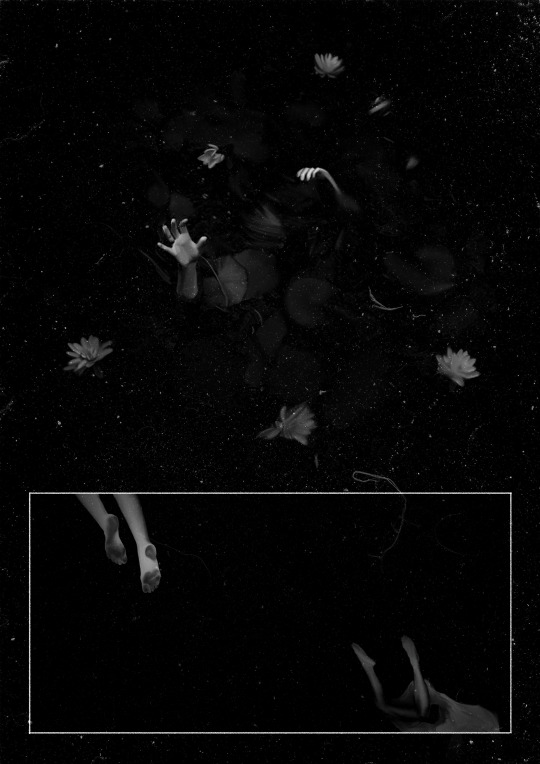
Page four
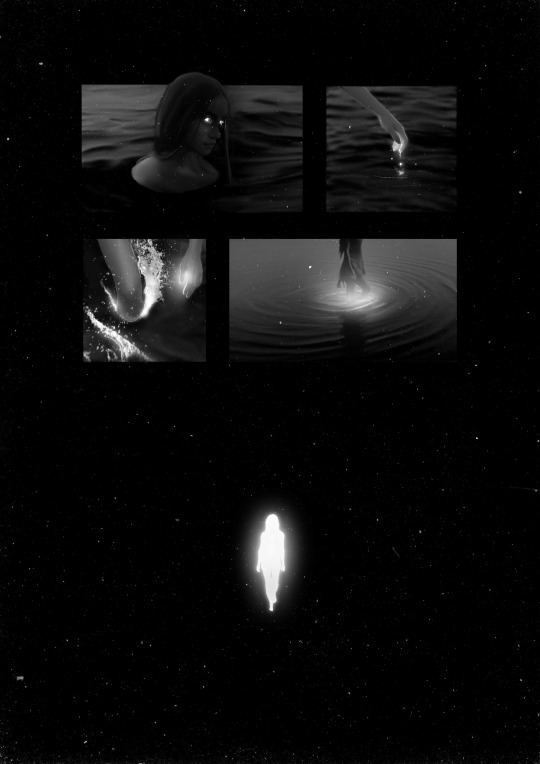
Chapter three

Page five

Page six

Page seven

Back cover
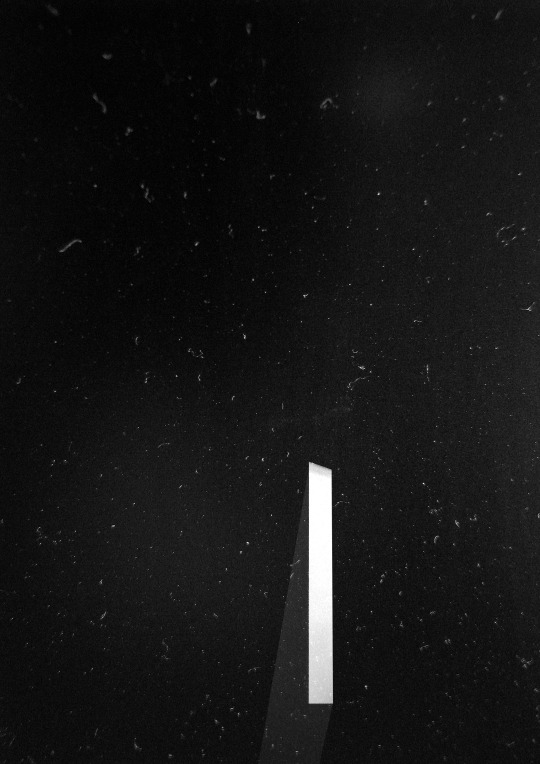
0 notes
Text
𝕮𝖔𝖒𝖎𝖈 𝖇𝖔𝖔𝖐 𝖈𝖔𝖓𝖋𝖎𝖉𝖊𝖓𝖙𝖎𝖆𝖑 - 𝕾𝖙𝖆𝖌𝖊 𝖋𝖎𝖛𝖊 | 21/06/20


How do we ‘read’ comics?
How do the images group together to form a narrative, and what theories does this follow?
Why does this happen?
What have I learnt reading Scott McCloud’s book?
Is it possible to improve or develop your comic adding sound or words?
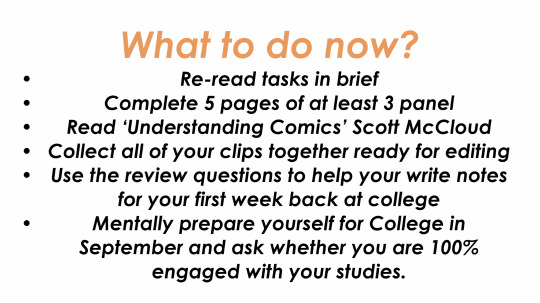
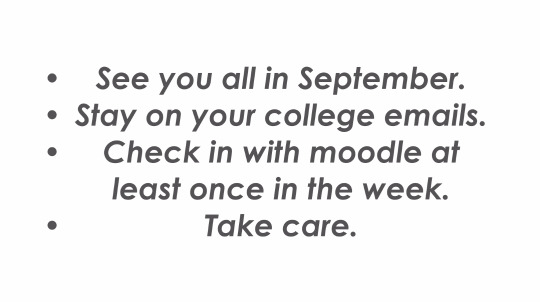
0 notes
Text
𝕮𝖔𝖒𝖎𝖈 𝖇𝖔𝖔𝖐 𝖈𝖔𝖓𝖋𝖎𝖉𝖊𝖓𝖙𝖎𝖆𝖑 - 𝕾𝖙𝖆𝖌𝖊 𝖋𝖔𝖚𝖗 | --/--/20
Follow instructions and points from PowerPoint;

How many panels do I need?
I have decided that with the comic I will be doing, not to limit myself to a specific amount of panels with the reason being, that I want this to reflect how we don’t know when the quarentine will end, thus letting it stay as an open door for expansion.
Well, how many pages is that?
That I don’t know, though I am aiming for over 10 pages.
Do I need to have a story?
I feel like that depends on what kind of comic one whishes to create. If you don’t focus on a storyline, the comic would most likely become more of an abstact collection of images, thus making the viewer able to fill in the blanks and create their own story.
I am looking to go for a story, but keeping it open for interpretation.
Do all comics need to have characters and a story?
The story part I already answered above; but having a character or no real subject as a focus goes hand in hand with an “open for interpretation” story/comic.
If the story is about me, am I the protagonist?
That depends on how the comic is excecuted. You can create a persona based heavily or slightly on yourself; your own values, your instincts etc. but that doesn’t mean that the character itself is actually you/looks like you.
How do I explore the themes of lockdown?
By isolating what the most significant elements of the lockdown have been, such as mental health, to then flesh them out into a physical illustrative representation of my experience of the lockdown.
Examples of non-verbal comic strips in a variety of different lengths by a variety of different artists:




0 notes
Text
𝕮𝖔𝖒𝖎𝖈 𝖇𝖔𝖔𝖐 𝖈𝖔𝖓𝖋𝖎𝖉𝖊𝖓𝖙𝖎𝖆𝖑 - 𝕾𝖙𝖆𝖌𝖊 𝖙𝖍𝖗𝖊𝖊 | 15/06/20
September is shaping up for the students taking the second year (extended diploma), and so far, it seems that we will be around 20 students by Sep. Due to the pandemic, we will most likely be coming into school in groups of 10 as we easy into it; at the same time, our grades are coming up soon, so we are asked to stay tuned for any news regarding this.
We had our third zoom meeting; this time focusing on how we are going to go forward with this project, practically speaking.
Topic: Animation & Illustration Progression - Review of Viewfinder drawings
Time: Jun 15, 2020 11:00 AM London
Hi guys,
Mondays class will review Viewfinder drawings and also we will show and tell progress, asking the question well how do we turn this into a comic.
The aim is 5 pages of at least 3 panels by the time we return in September....I am just checking on progress towards this.
See you Monday,
DD
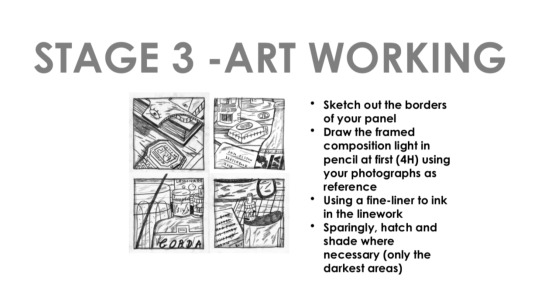
How can we connect what we have done so far with the goal of this brief (making a comic)?
Gutters are important to comics, as they are what differenciate the panels from eachother, allowing us to convey a sense of time and space – essentially becoming a time traveler. Because of the gutter, we get a sense of closure at the end of each panel, which then connects to the context of the next panel.
Something similar to this that we did last year was our post it note sequences; they were made up of seperate frames, but came together to create one image; a story/narrative/meaning/visual. At the same time; the post it note comic brief that we did this year is again, very similar to what we are trying to create with this project, only much more refined.
We are still required to being open to experiment with the medium/mediums we have chosen or planned to use for our comic strips. An example of this could be the artist we study, Sam Elston and his use of ink:

Here he has done some light sketching and then gone over it with a brushline; keeping in simplistic and clean.
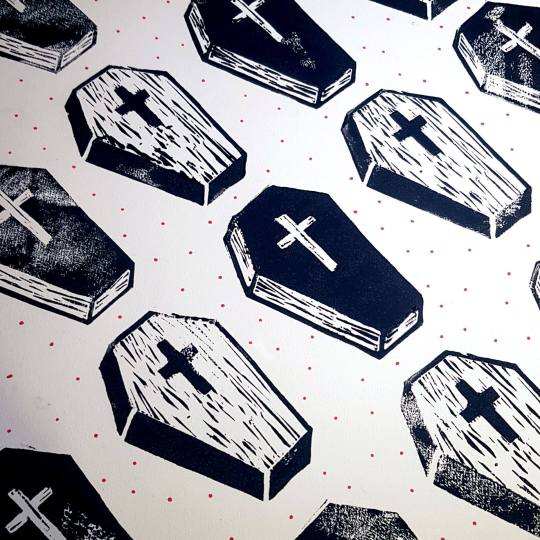
Where as here he has done some lino printing; creating some really interesting textures, also causing irregularity between the pattern of the coffins, engaging the viewers eyes to look at them not only as a whole, but individually.

Here he is using coloured ink to make each character pop out between the linework as well as to further convey that they are devils.
This is all the same medium; but used differently- exactly what we are aiming to be doing. - We are not required to use fine-liners and/or ink, but any kind of medium that we would like. All we have to keep in mind is tone and texture; much like last weeks example of Jon McNaught’s work.
- Art can be whatever you want follow basic instructions from Powerpoint link processes back to artists we look at.
- Read pages of book on panelling comics to aid the creation.
- Think about texture and tonality

McCloud animation book, on transitions; how we move from one frame to another. This is a crucial element in comic although it seems obvious. There are 6 different ways this can be done, determining how we read and understand a comic.
section 1.
Moment to moment. It is similar to animation and sequences; little changes making it look as if it is moving, creating fluidity; needing very little closure this making it is easy to understand and read.
section 2.
Action to action - similar to the idea of animation - show the frames as the first and last frame of a sequence ? the before and the after. still in the moment.
section 3.
Subject to subject is a little more complex compared to the previous two. getting reader more engaged. you don’t have to look much to understand the previous two, but for this you must work a little harder as a reader. Involving the readers is crucial, and it can be done with this with a dramatic scene, creating a plot/story.
section 4.
Scene to scene. Moving to country to country/time traveling can be a powerful tool for convey time. An example of this could be a a frame of someone in a field with a tree, then jumping to a shot inside your kitchen.
section 5.
Aspect to aspect can jump through time and space easily. We are not worried with time for this as we can jump through it– setting up a place and mood. An example of this could be the example from last week of Jon McNaught’s comic.
section 6.
Non-sequential is when you almost do a jump cut; showing a harsh juxtaposition between subjects (frames).
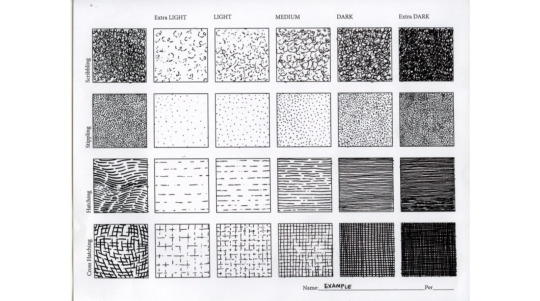
We are expected to be looking at a range of different mark making, again, to experiment with our chosen medium/mediums; all to create a sense of depth.
I would like to focus on doing most of my comics digitally; since i feel that this, as a medium, is quite misunderstood as being “fake” and not as valued as “traditional” art such as pencil, paint, sculpting etc. -
With this in mind, we must make sure that we aren’t just doing “whatever” “just because”, but for a reason; this being mine.

This project is just for us to have a go at it; to do some research if unsure, but make sure to look at some comic books to reflect upon.
By the end of the meeting, we shared our work with the class; giving feedback to each other on how we now put them into a sequence for our comic strips? We left with the mention of making sure that we keep in mind that this projects is just to test our skills of sequential art, observational art and rendering, giving us an opportunity to experiment.
0 notes
Text
𝕮𝖔𝖒𝖎𝖈 𝖇𝖔𝖔𝖐 𝖈𝖔𝖓𝖋𝖎𝖉𝖊𝖓𝖙𝖎𝖆𝖑 - 𝕾𝖙𝖆𝖌𝖊 𝖙𝖜𝖔 | 08/06/20
We had our second Zoom call in which we spoke about what research we had done thus far during the first stage of the comic book confidential brief.;
“David Dixon is inviting you to a scheduled Zoom meeting.
Topic: Level 3 Animation & Illustration - Research Discussion
Time: Jun 8, 2020 10:30 AM London
Hi guys can you please all ensure you have a pen and paper and also if you would like to bring a comic you have researched to share, you will either need the physical comic or an image on your phone/computer to share with the group.
We will do a quick compare and contrast exercise using examples from last week as well as give you an opportunity to ask any questions about the next steps.
I would like to see all of your Cardboard Viewfinders please! Also can you all remember the rules of Zoom classes:
No bedrooms / No bad language / Full engagement & particpation is required if you are planning to progress to Year 2.
Best,
DD”

Create a viewfinder
For my viewfinder, I simply just found some scrap cardboard that I always keep hold of for spontaneous projects, and cut some squares into it; not thinking too much about the placement and/or execution since I wanted it to be as random as possible.
This is what I ended up with:

I also found that you could get different results by simply tilting it 90 degrees;
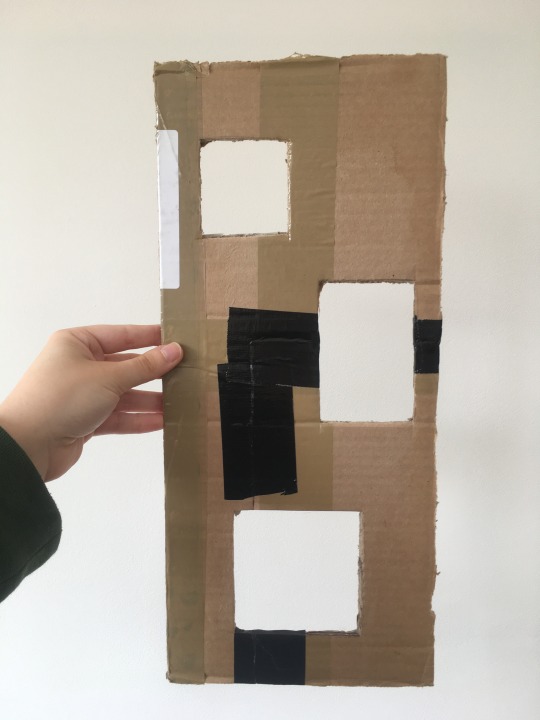
What are the benefits of using a viewfinder?
Using a viewfinder can prove to be incredibly useful for making your mind focus on frames within a frameless scene that you may not have picked up on without it. I have already tried using it outside of the comforts of “my” house, and have noticed that just how useful and successful it has proven to be in doing this.

Below are some of the pictures I have taken so far whilst using the viewfinder;

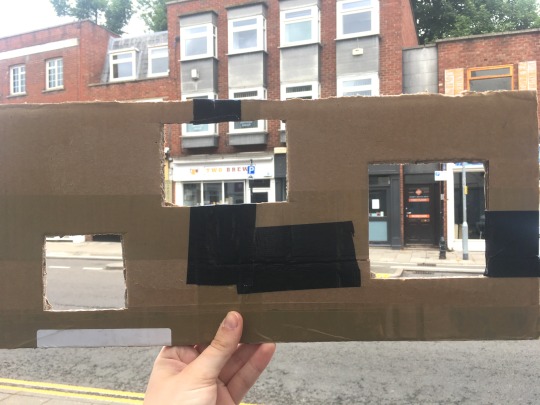



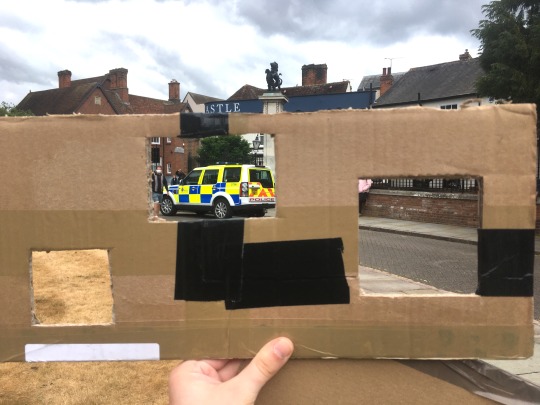


Are all comics panelled?
Personally, I have rarely seen any comics without any form of panelling, but occasionally I have seen it used on for example just a single page/double page where it’s just a tiny subject in a big void of nothingness; like a little rocket on a blank page, making it feel like somewhere lonely and perhaps ominous. So to answer this question; no! It is not required to make a comic work!
What happens when we frame a composition?
It guides the viewers eye to the frame and the content within it. It also seperates each frame from the other, making it look like different moments of time, thus creating the “gutter” (the space in between the frames) that causes us to read it not as a flow of time, but like intervals of time.
What are the themes of isolation/lockdown?
Positives: Self-care, breathing space, appreciation for what you haven’t got, nature, hobby productivity, cleaning/organising, baking/cooking, mediative space, spontaneous and trying of new things, going back to nostalgic things, spending more time with family/people you live with, exercise, body positivity, self awareness, social media in the sense of being able to stay in touch with whom you care about but can’t meet up with.
Negatives: Paranoia, confusion, chaos, loneliness, feeling of being trapped, depression, financial stress, university/schooling, traveling/cancellation of plans, helpless, the news/social media/bad news everywhere.
How will you communicate these in your comic?
I had pondered this for a while, and couldn’t seems to decide what direction to go with for my comic, so, I thought back to previous briefs and found that doing a mindmap might help me. So that is what I proceeded to do:

I came to the conclusion that I found myself more intrigued of the idea of creating something dark; reflecting the negatives of quarentine, more specifically, my own experience of quarentine. Although the comic will be primarily focusing on the negatives and the darkness of it; it will still have a few hidden positives within it.


- Do rough sketches working from references, but do this once we are confident in our research!
0 notes
Text
𝕮𝖔𝖒𝖎𝖈 𝖇𝖔𝖔𝖐 𝖈𝖔𝖓𝖋𝖎𝖉𝖊𝖓𝖙𝖎𝖆𝖑 𝖆𝖓𝖉 𝖘𝖚𝖒𝖒𝖊𝖗 𝖕𝖗𝖔𝖏𝖊𝖈𝖙 - 𝕾𝖙𝖆𝖌𝖊 𝖔𝖓𝖊 | 02/06/20
There are two types of textures;- Implied texture is basically texture that appears to be there, but it’s an illusion.- Actual texture is texture that exists and can be felt by touch.So I have been falling behind with what we as a class have been doing online on Moodle, making it feel increasingly difficult to approach it and get things done since it feels like things just keep piling up, but I have decided to give it a shot and just go for it!
The following message/messages were left for us on the Moodle forum;
01
“Hi guys,
Thanks to those that attended the Zoom meeting this week. Well done.
If you are committed to progressing next year I will need to see the following:
- Post a reply to this thread to show you are checking in with Moodle
- Interact with a least 1 of the summer school activities
- Attendance at ALL subsequent Zoom classes.
- A Conscientious and studious approach to the summer project
The time line for what happens next in terms of your studies will be as follows:
Tuesday 26th May - Summer project posted to Moodle and emailed directly to college emails (This will give you a chance to read/obtain equipment/purchase core text)
Monday 1st June - Zoom Lecture - Reviewing the brief and discussing research activities and practical tasks. Q & A
Monday 8th June - Zoom show & tell - Discussing progress so far / issues / findings / examples / Work in Progress
Monday 15th June - Zoom Break out groups / Smaller discussions
Please if you are in contact with any of your classmates/peers who have not be interacting can you please encourage them to do so, the longer we abstain from learning the harder it will be when we do get back to the 'New normal'.
Happy Wednesday!”
- Post a reply to this thread to show you are checking in with Moodle
I posted a short reply to show that I am active on Moodle.
- Interact with a least 1 of the summer school activities
I am yet to do this, but will be attempting my best to catch up.
- Attendance at ALL subsequent Zoom classes.
I have already failed this, but will attend the Zoom classes schedule ahead.
- A Conscientious and studious approach to the summer project
I will be working towards living up to this over the next few weeks as we work on the Summer School Project.
02
“Hi guys,
Hope you had as good bank holiday, here is the Summer project as promised. 'Comic Book Confidential' is a project that will allow us to start thinking about the type of work we will create in our 2nd year as well as addressing the theoretical and academic ideas we will need to start thinking abound discussing in detail when we return.
This week, I want you to do the following:
- Read the brief thoroughly and write down any questions you may have
- Order your core text book, Scott McCloud's 'Understanding Comics: The Invisible Art'
- Obtain any of the necessary equipment if you do not currently have this
Please ensure you start your research from Stage 1, and begin to write notes for the questions; as I will be asking you to relay your new knowledge next Monday (1st June) in our first Zoom lecture/discussion. I will forward an invite in a separate email and on moodle. I look forward to working with you guys on this, it will be a good one.
Best Regards,
David Dixon”
𝕮𝖔𝖒𝖎𝖈 𝖇𝖔𝖔𝖐 𝖈𝖔𝖓𝖋𝖎𝖉𝖊𝖓𝖙𝖎𝖆𝖑
The brief;
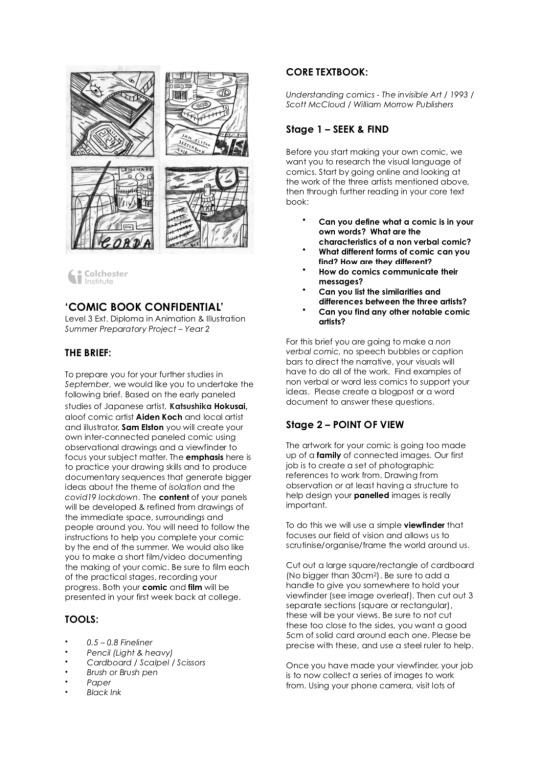
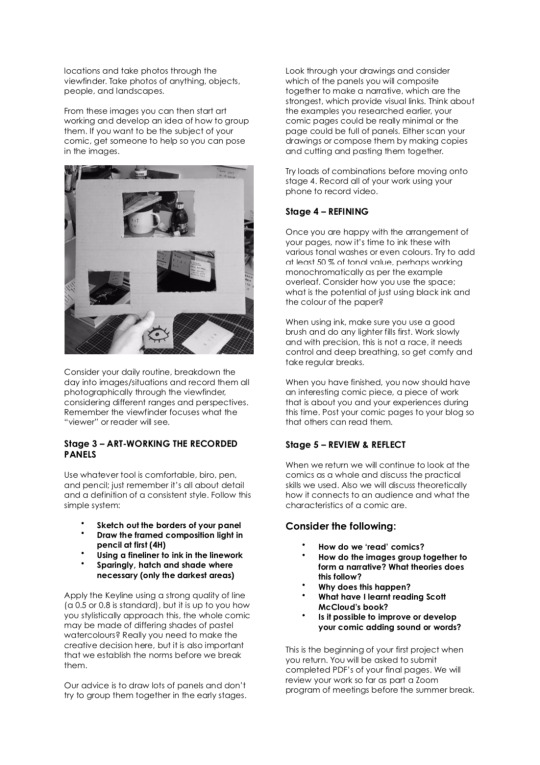
03
“Hi guys,
Thank you everyone who joined us yesterday for the launch of our Comic Book Confidential Summer Project, there was a great turn out.
I have attached the PDF of the presentation for you to look at and use as a resource.
Please begin stage 1 and make sure for next week you have your viewfinder made and you are able to talk about either a comic book of your choosing or answer some of the questions of stage 1 with clarity.
Any question please post to here and I will answer as soon as possible.
Cheers
DD”
I missed this zoom call, but got some notes and insight to what was talked about during the call from a peer.
This brief is the first surrounding the topic of sequence art/comics that we have done as a class. Comics can be described as being a “sequence through illustration”; a series of images, sometimes with no dialogue showing an action or conveying a space of time in just a few panels, like glimpses of a film, showing key moments to portray the meaning of the sequence.
On another note, we are allowed to animate the project if we want to.
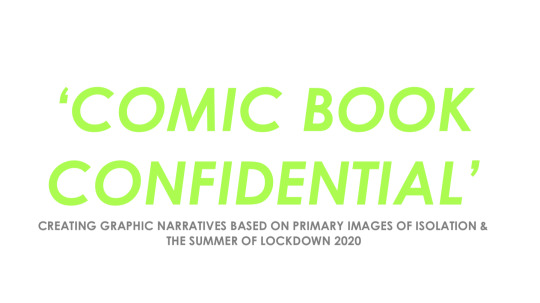
For this brief/project, we are required to put some form of narrative together, based off of our own personal experiences with the 2020 lockdown, making it a personal project to each of us. It is also required to be non verbal.

During the process of making our comic sequence, a short film showing the process from start to finish.
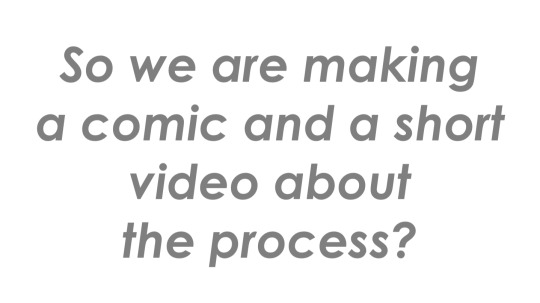
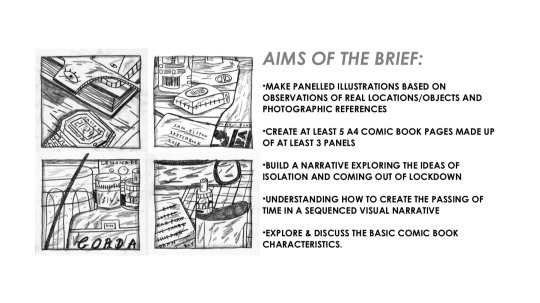
AIMS:
Make at least 5 comic book pages with at least three panels per page
Build a narrative exploring the ideas of isolation and coming out of lockdown
Understand how to create the passing of time
Explore the basic characteristics of a comic, BASICS!
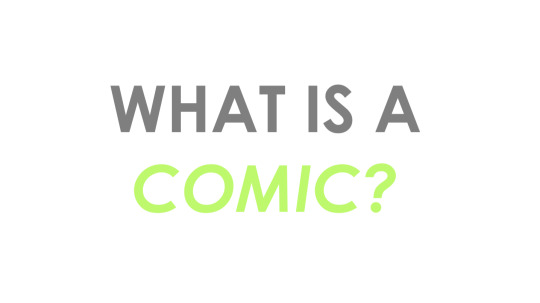
A series of juxtaposed images creating a narrative or a selection of images.
An aesthetic response to our viewer done using a selection of images in a deliberate sequence. - “Sequence art”
Can we link this back to year 1?
I did a workshop at the very beginning of the year (19/09/19) called Fragments/Clips. It focused on experimental editing and making something unconventional with what resources we were given, much like we are asked to do with this brief; creating comic strips from the resources we find within and around us.
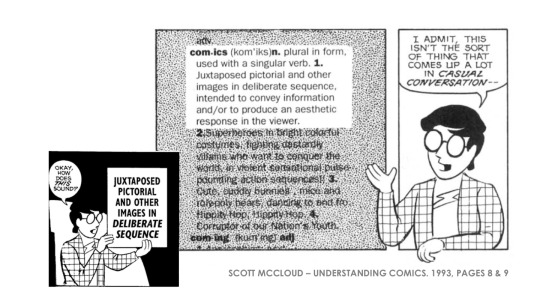
𝕶𝖊𝖞 𝖆𝖗𝖙𝖎𝖘𝖙𝖘:
We can find our own if we like but the suggested artists are;
- Hokusai
- Aiden Koch
- Sam Elston - former student from our course that will be visiting us.

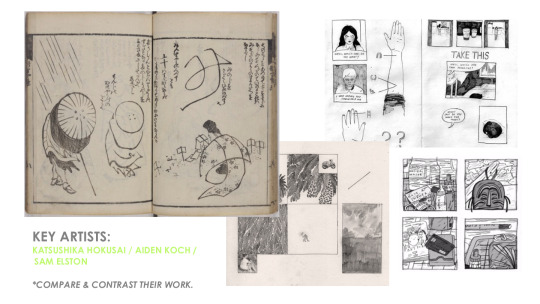
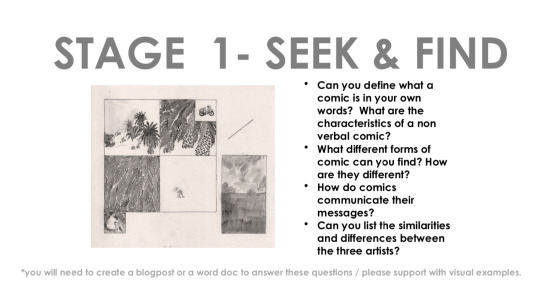
Can you define what a comic is in your own words?
Comics can be described as being a “sequence through illustration”; a series of images, sometimes with no dialogue showing an action or conveying a space of time in just a few panels, like glimpses of a film, showing key moments to portray the meaning of the sequence.
What are the characteristics of a non verbal comic?
The primary characteristic for non verbal comics is the lack of words used. Non verbal comics are told solely through illustrations that, when you “read” it, will come alive like an animation that doesn't move. An example of non verbal communication could be something as simple as a smile, often indicating happiness, or perhaps a lack of expression can indicate boredom or something of a much darker background, like contempt or bloodlust.
What different forms of comic can you find, and how are they different?
A number of comic genres pop into mind immediately; Science-fiction comics, Superhero comics, Fantasy comics, Teen comics (humour), Adult/Erotic comics, Manga etc. Comics can also come in many different types of mediums, some that I can think of being Webcomics, Graphic Novels and Comic books.
How do comics communicate their messages?
In comics, with both verbal and non verbal communication within them, the major selling point is the illustrative work. Each panel represents a time, with each gap between the panels representing a passing of time. Much like glimpses of a sequence, put together in a harmonic composition with the goal to be compelling to ones eye. The message/messages that the artist want to portray can be executed through visual language; line, shape, form, texture, value and colour. All of these elements play into a successful comic strip.
I will give a simple example of each of these used to convey the same thing;
* Note that all of these will be left as examples and may look a little rough around the edges since they are just there to show the effects of visual language and nothing more.
Line:
Within visual language, line work is one of the most prominent and frequently used across all comic genres. In fact, the earliest comic that has been traced back to being from 1837 is made up of only line work, meaning no use of colours, values, textures etc.

It was called The Adventures of Mr. Obadiah Oldbuck and was originally published in several different languages across Europe, among them an English translation meant for the British in 1941.
For this first example, I have used only line work and included some shading using various hatching techniques (much like what has been used for the comic of The Adventures of Mr. Obadiah Oldbuck). This has resulted in a very classic feel of comics, made up by only blacks and whites.

I attempted to make this classic style transform into a more modern style by applying a few halftones on top, resulting in the following outcome:

As you can see, by applying these halftones as overlays, the piece successfully achieves the look of a manga/comic book/webcomic, rather than the previous classic style.
Shape:
By using shape in art, one can easily and effectively archive much with little. Shapes can be used in several different ways to convey different emotions. Because this ‘comic’ page is based on action and a narrative of climax, I chose to emphasise on sharp edges as they are commonly known to communicate danger. For example, I changed the smoke into fire and made it look much alike shattered pieces of glass, yet again to indicate it as being something dangerous to touch.

Each line is straight and rarely bends; creating some interesting shapes, squares, and triangles;

Form:
Form is most often describes and applied to something that is a three-dimensional subject, such as clay sculpting, although generally speaking, it is connected to things that are 3D, (three-dimensional) meaning there is an aspect of extra depth that you can’t normally archive with 2D. This is emphasised by light and dark values. (low and high contrast), otherwise known as shading.
For this example I attempted to make the line-art I had done earlier feel more real and lifelike by adding these different shades of grey.
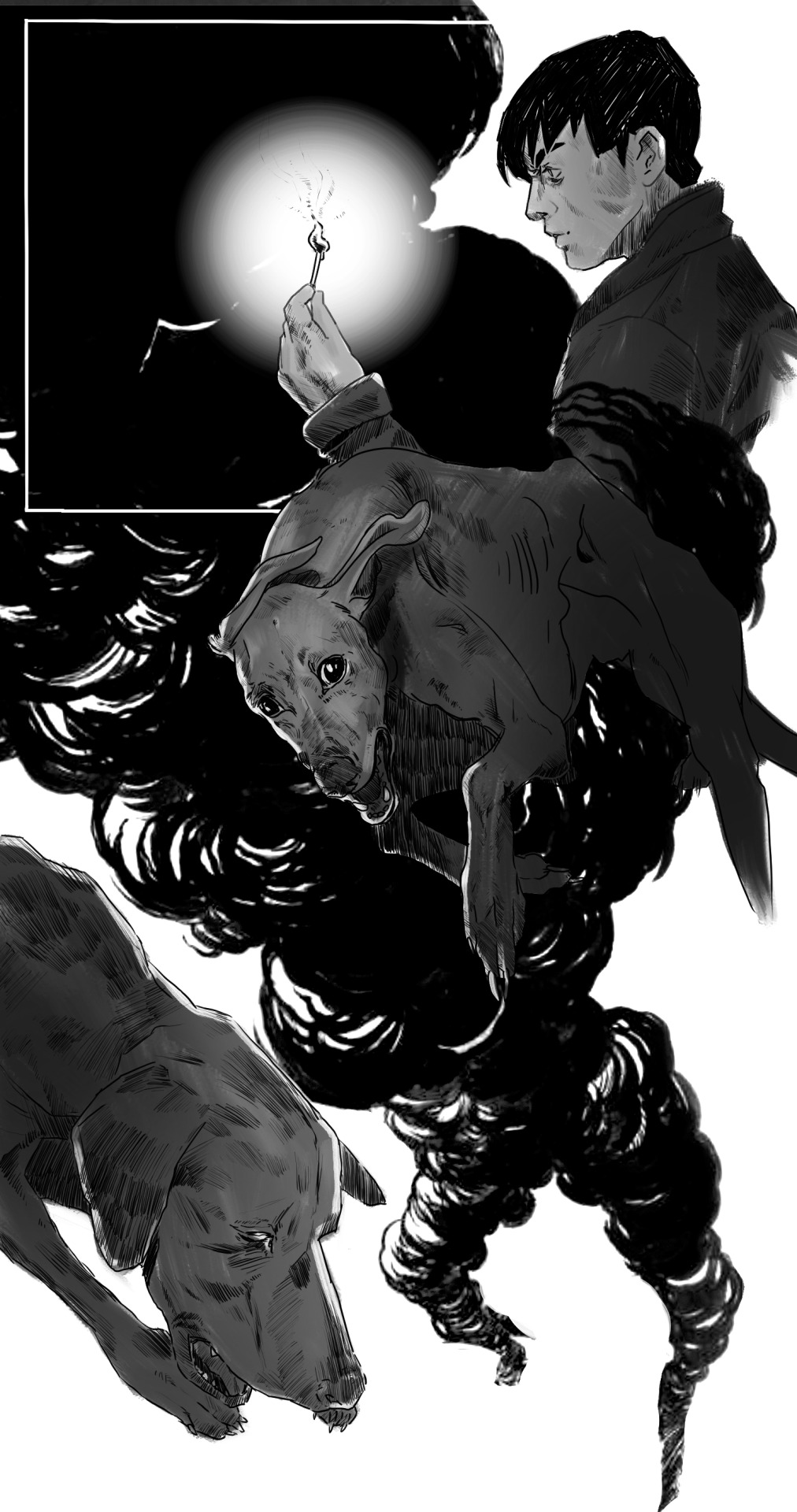
Texture:
There are two types of textures;
- Implied texture is texture that appears to be there, but is really an illusion.
- Actual texture is texture that exists and can be felt physically by touch.
Since I am doing this digitally to speed up the process, I will be doing this by using the technique of implied texture.

For a long while now, I have been building up a collection of high quality scans and pictures of a large variety, based on the advice of my teacher when we were playing around with the visual language of texture in a past project. Out of these, I chose just a couple to play around with in Krita;


Now all that was left to do was to layer these on top of the artwork I had done earlier and have, as I mention before, a play around with them using different layer modes such as colour dodge, screen, overlay, soft light, hard light, multiply etc. I came up with a handful of different textured outcomes, but will be posting just a few of my favourites and put the rest into a gif;

The reason that I chose this one as being one of my favourites is due to how successful both the textures layered together translated so clearly and well. It gives a lovely look of it being aged as if it were torn out of an old comic book and scanned into a computer.

Now this one I am especially a big fan of! Although inverting the values got rid of the majority of the details within the art work, It doesn’t take away from the subjects and narrative, but the most compelling thing about it is how it strongly reminds me to the look of lino printing.
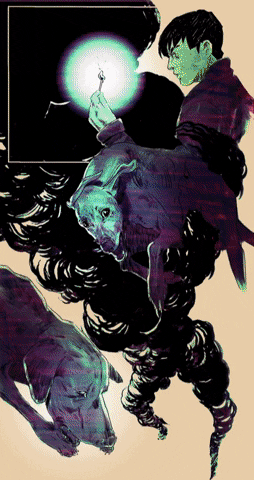
An example of a great artist I found that specialises in this medium of artwork is Valdis Baskirovs. I have chosen to compare their work to this comic strip in particular because their subjects are also most often animals, including canines.
Below are some examples of their work and work process doing lino printing:

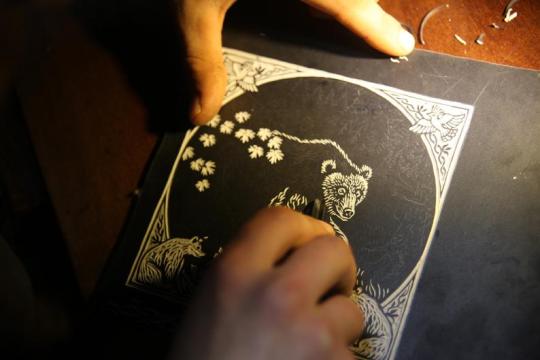

Value:
Value is often described as a way of drawing with light, where value is based on how light or dark a given colour or hue is. Values can easier be understood once they are visualised on a scale or a gradient.

The scale above ranges from white to black, with a number of grey tones in between, but any hue/tone has a similar scale that goes from light to dark;

Different colours or values can be achieved by adding light or dark hues, in the case shown above, adding white to it to lighting it, or by darkening it with black.
Colour:
Last but not least, colour is an incredibly important part of visual language. It is used to convey a feeling, narrative or meaning within a given piece of artwork.
For this comic page, I have decided to go for a more cartoony and simplistic style, since that is what the line art communicates with it’s sharp and clear edges; but instead of just splashing any random colour on, I wanted to try and make it monochromiatic, meaning that all the colours have the same base tone, and therefor relate and harmonise with each other. The base tone for the example shown below is a muted orange-yellow.
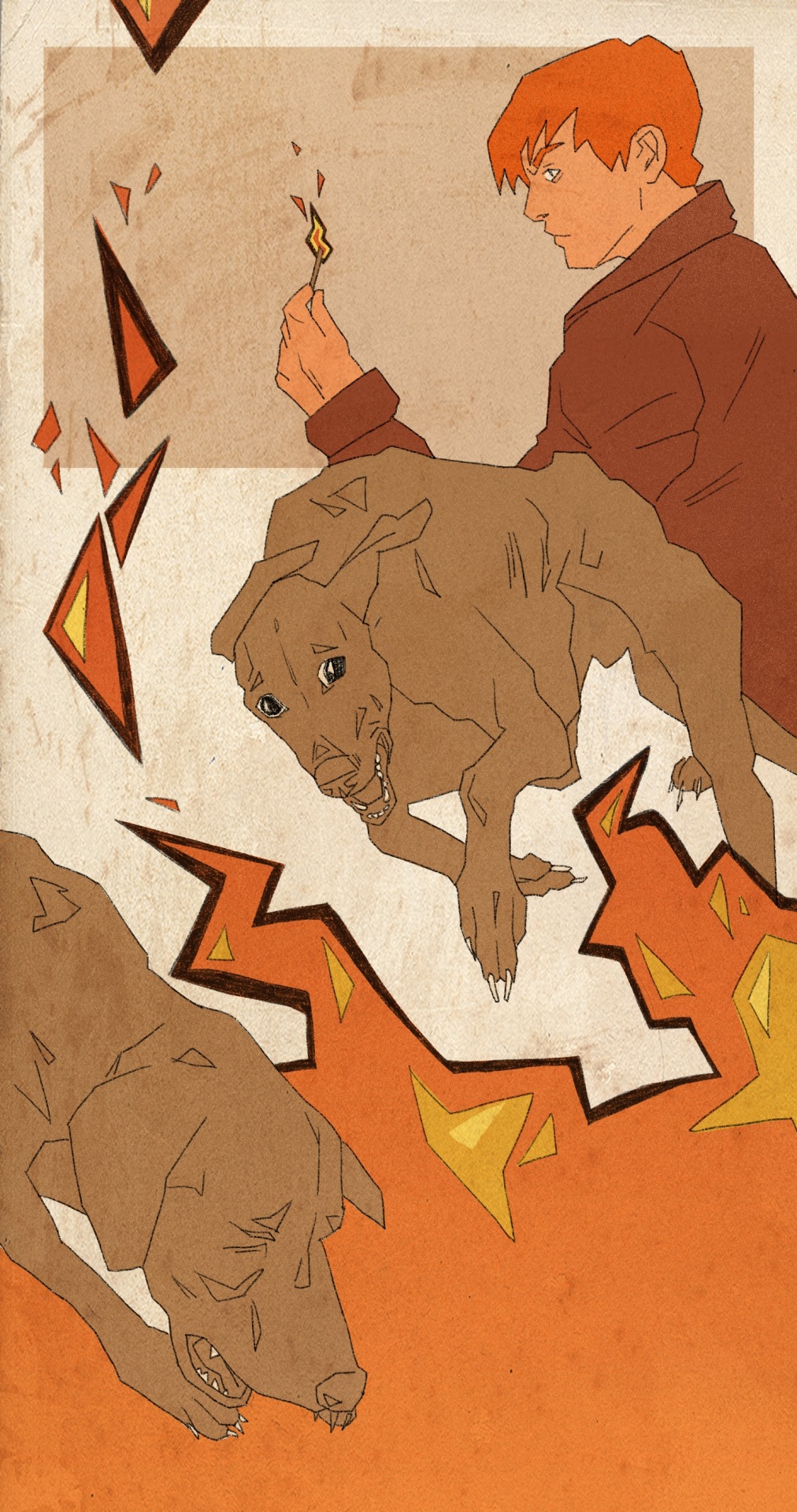
I applied a layer of texture on top for two reasons; one being to make the piece feel more connected, but also for the reason being that this texture makes the page look like damaged or burnt paper, again to subconsciously communicate the fire being dangerous.
Can you list the similarities and differences between the three artists (Katsushika Hokusai, Aidan Koch & Sam Elston)
From looking at these three artists work side by side, I came to notice that they all seem able and confident in portraying more with less. Everything from line work and choice of colour is basic, simple, yet it still shines through as strong artwork. It feels like there is room to breathe due to the lack of business.
All of the three pieces of artworks shown below have the above in common. They feel light and minimalistic, using a variety of pastel colours and light values with the occasional dark black lines and/or splashes here and there.
I will be keeping this in mind for when I attempt drawing my own non verbal comics/sequences - the saying that less is more.

Example of the work of Katsushika Hokusai.
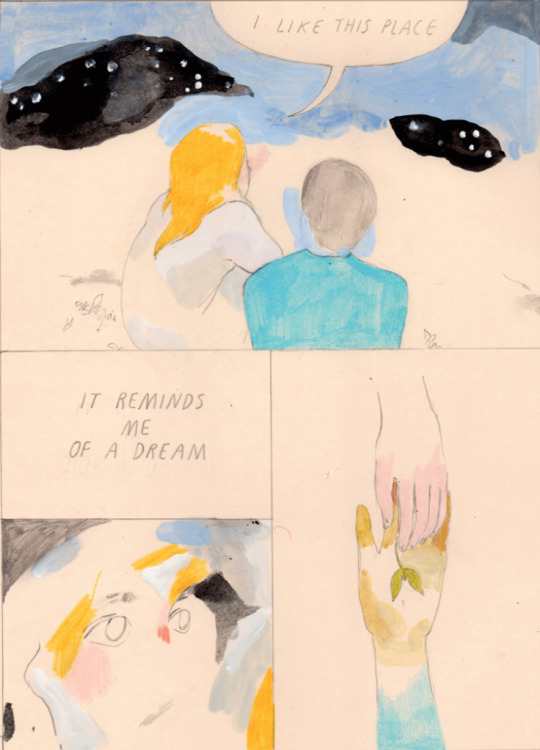
Example of the work of Aidan Koch.

Example of the work of Sam Elston.
- - -
𝕱𝖗𝖆𝖓𝖘 𝕸𝖆𝖘𝖊𝖗𝖊𝖊𝖑
Frans Masereel (1889–1972) is the creator of the wordless graphic novel “The Sun”, or “Le Soleil”. Frans was a Flemish painter and graphic artist whom worked primarily in France, completing over 20 wordless novel during his career, with his novel “Passionate Journey” or “Mon livre d'heures” from 1919, allegedly being his best work.

“The Sun”/“Le Soleil” Consists of 63 pages showing prints from woodcuttings, and is a contemporary retelling of the Greek myth of Icarus. Briefly explained, the protagonist of the novel continuously attempts to seek to the Sun by any means possible, but before he succeeds, he is sent plummeting back down to Earth.
𝕾𝖍𝖆𝖚𝖓 𝕿𝖆𝖓
Another artist that has added to the genre of wordless novels is Shaun Tan, which work we have studied for a past brief before. I will be talking more particularly about his graphic novel “The Arrival”, originally published in 2006, it is made up by 128 pages intricately drawn in pencil and later edited to fit the aesthetic and look off an old book.
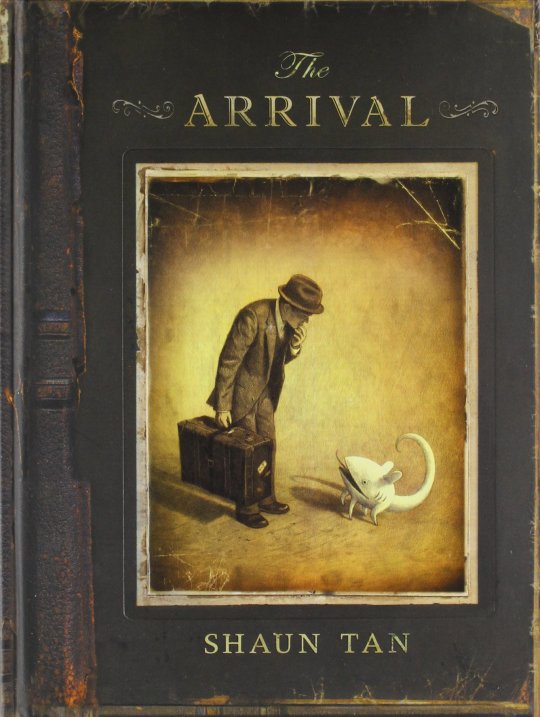
After “reading” through this graphic novel, I was left thinking that this book is very touching and makes your mind wander off in thought.
It follows a man that cannot use words, thus the readers are experiencing everything as he is; silently. The protagonist, a man, leaves his wife and daughter to board a steamship to cross the ocean; all for the reason of building a better future for his family. - This book touches on the journeys that immigrant’s go through and experience on their travels. Although the reader clearly experiences the mans inner isolation, they also get to share his new found joys.
Below are some of the pages found within this book:
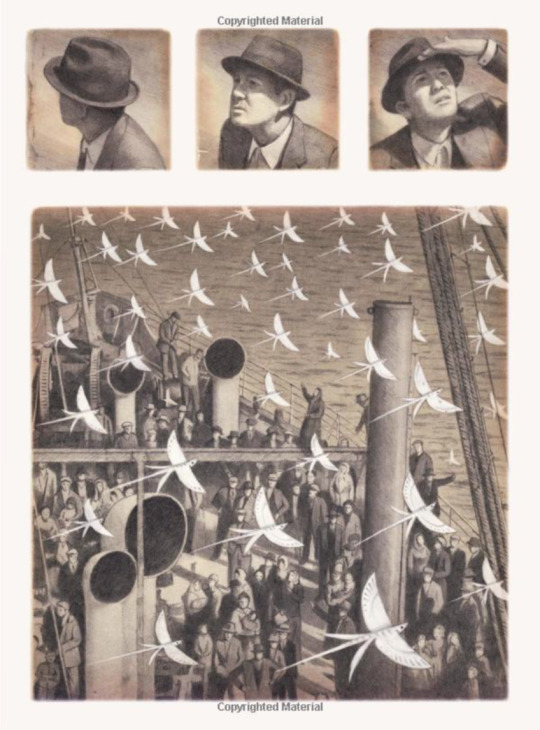

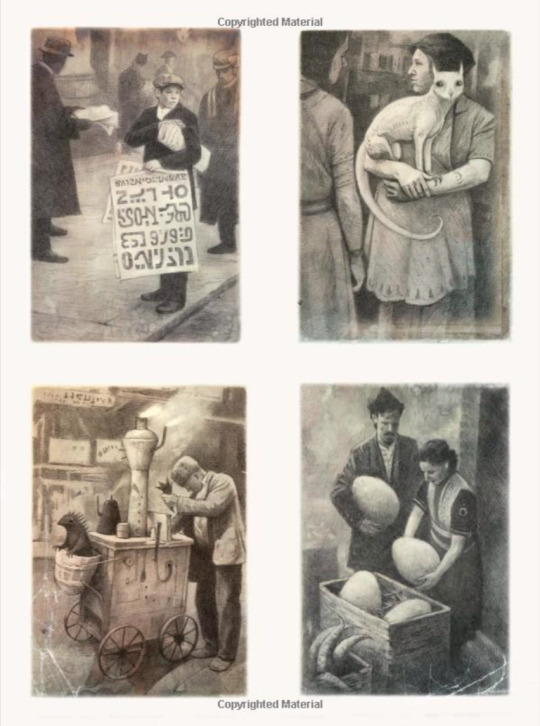

3 notes
·
View notes
Text
𝕬𝖚𝖙𝖔𝖒𝖆𝖙𝖎𝖈 𝖊𝖓𝖈𝖔𝖚𝖓𝖙𝖊𝖗𝖘 | 30/03/20
For this week, we have a new workshop to do, tying into the first brief (Pick & Mix), focusing on surrealism and the theories linked with this by psychologist Sigmund Freud.
vimeo
Attached was the following text written by our teacher to introduce this workshop and the tasks that come with it;
“After a successful week with the post it note comic, and some excellent write ups that are really well documented, this week's task revisits some of the work from Term 1 (as we started in our drawing sessions) with some of the ideas stemming from Surrealism, dada and the psychoanalytical theories of Sigmund Freud.
This task is presented by Bristol based artist & animator Will Barras who will be offering commentary on your work at the end of the week. Follow the PDF attached and work through the tasks at your own pace. You have all week so take your time and experiment as much as possible.
We have more challenges to come, so try to put time into these as they will form the main body of your experimental work.
Upload your results and be as creative and imaginative as possible, but most importantly let go and embrace the ride.
Good luck peoples!”
Consider the primary objectives of a Final Project:
Collect information (Research)
Recall knowledge (Use learning)
Apply understanding through application and review (Propose & make exciting work and evaluate it)
I find that the above points refer to a simplified process of working through meet the final goal that is set by the FMP, althought this also applies to workshops and side projects that gets documented on this blog, as well as the productionfile.
Question: Are you doing these things and how can we improve and develop this?
I feel that I already do these, althought I yet have to further improve on evaluating the things I do, asking “Why” more often.
Answer: Experimentation - (The action or process of trying out new or revisiting ideas, method and activities)
≡≡≡≡≡ ≡≡≡≡≡ ≡≡≡≡≡ ≡≡≡≡≡ ≡≡≡≡≡ ≡≡≡≡≡ ≡≡≡≡≡ ≡≡≡≡≡ ≡≡≡≡≡
This weeks aims & objectives:
To review basic principles of automatic practice in relation to a specific artist
To experiment with working from abstract starting points
Be generate experimental work that shows progression of learning
To compare your work to the work of others

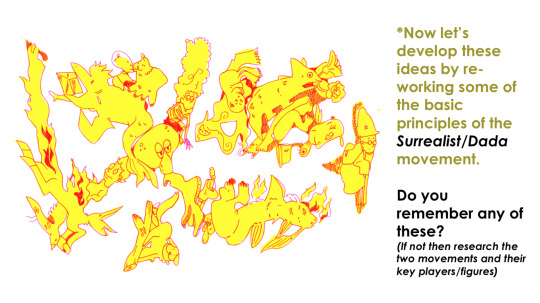
The surrealist/dada movement was an art movement, as well as a literary movement, that began around 1915 - 1917. Some of the key artists leading this movement was Hannah Höch, André Breton & Max Ernst. The movement aimed to break free from the chains that weighed down everyone during the great depression- The artistic field had now begun to evolve into a playground for ones’ imagination, challenging what used to not be acceptable in common culture.
Accident & chance
Embracing Improvisation (What does improvisation mean to you?)
BEING AUTOMATIC!
Surrealist automatism is a method of art-making in which the artist suppresses conscious control over the making process, allowing the unconscious mind to have great sway
Unlocking the unconscious mind.
In Sigmund Freud's psychoanalytic theory of personality, theunconscious mind is a reservoir of feelings, thoughts, urges, and memories that are outside of our conscious awareness.
≡≡≡≡≡ ≡≡≡≡≡ ≡≡≡≡≡ ≡≡≡≡≡ ≡≡≡≡≡ ≡≡≡≡≡ ≡≡≡≡≡ ≡≡≡≡≡ ≡≡≡≡≡
𝕽𝖊𝖘𝖊𝖆𝖗𝖈𝖍:
This weeks challenge for experimentation is bought to you by Bristol based urban artist and animator Will Barras. Your task is to analyse his work, considering the effect of the visual language (how he uses line and tone for example). Find out about him and considering the aforementioned surrealist principles write a short statement to suggest how he uses those principles in his own work.
Will Barras
vimeo
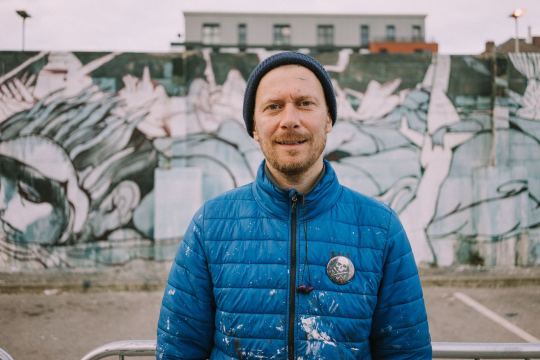
Illustrator, artist and animation director, Will Barras, currently lives and works in London, althought he grew up in Birmingham and later moved to Bristol to study graphic design. He quickly became known for being part of a group of young artists, working within Bristol’s street art scene. This then led to him appearing in a book titled “Scrawl”, alongside the artists Steff Plaetx and Duncan Jago, becoming a core and founding member of the Scrawl collective. “Scrawl”, originally published in 1999, was an influencial book made to document a new movement in street art, graphics and illustration.
Barras was selected to be one of the original artists for this collective. He was selected due to being renouned for his methods of portraying fluidity in movement. He also worked closely with creating pieces that were more narrativly driven compositions, incorperating such narratives into his line work. Barras’s unique composition of these three key elements, made his mark as an artist all the more inspiring, pushing new ideas against the grain of classic art. All of this has led his work to become staple pieces in many galleries across the globe. This includes Asia, Europe and the U.S.
He has painted a variety of different murals around the world, within this mix is one that he did with the members of his Bristol group at Tate Modern’s tubine hall, as well as one that he did for Pow!Wow! Festival in Taipei. In the studio Th1ng, located in central London, he worked as the head of animation.
Visual analysis and study:
His artwork has a very recongnizable style and feel to it. It has an urban flare to it, making it feel very fitting within the scene of street art.

“A big barn I painted in Dumfries with Amy Winstanley for the Spring Fling festival and Recoat gallery based in Glasgow.
http://www.amywinstanley.com
http://www.spring-fling.co.uk
http://www.recoatdesign.com”
The painting below has little information about it, as for what I can find, but somehow the piece almost speaks for itself. The play on perspective, composition and values is very eyecathing. It impresses me how he is able to convey motion to such an extend that you can almost just imagine it moving before your eyes, but perhaps that’s just me.

“#divinestyler #defmask #gammaproforma #kallenbachgallery”
I attemped to do some simple continuous warping animation to convey what I mean a little better:
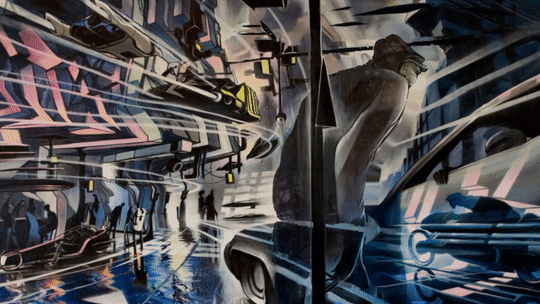
≡≡≡≡≡ ≡≡≡≡≡ ≡≡≡≡≡ ≡≡≡≡≡ ≡≡≡≡≡ ≡≡≡≡≡ ≡≡≡≡≡ ≡≡≡≡≡ ≡≡≡≡≡
𝖁𝖎𝖘𝖚𝖆𝖑 𝖆𝖈𝖙𝖎𝖛𝖎𝖙𝖞:
01: Using a wide brush create a large sheet of accidental/automatic/ unconscious blots & splatters, organics shapes and curvaceous marks using a range of coloured ink/paint. The brighter and more acidic the better!
Because of the fact that I don’t have paper made for paints/ink, I decided to try doing this task digitally- simulating the analogue look of watercolour or watered down ink, or even arcrylics.
I did this by using a variety of different watercolour brushes, made to emulate the look of the analogue mediums. I used them as randomly as I possibly could, trying not to plan where I would put the next brush stroke.
Once I had put down all the paint stokes, I then went over it while the layer was locked with a big soft edged brush, layering up different colours until I was happy with how it looked.
02: Make 3-4 sheets of these and then let them dry.
Digital 01:

Digital 02:
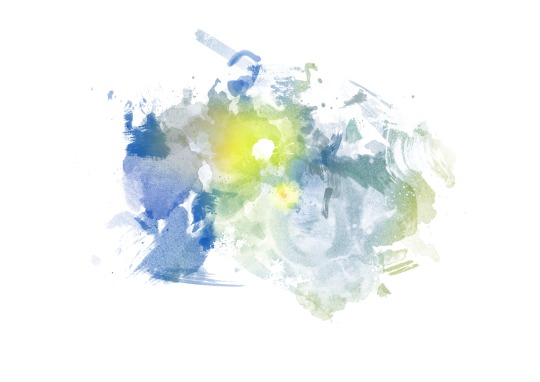
03: Then using fineliner develop these marks into faces/characters/scenes by adding details/features and developing these into detail illustrations that are spontaneous and free flowing.
For the linework, I primarily used one single brush; hard edged and circular. (The one selected in the picture below)

I chose this for the reason being that I have found it to be very responsive to the use of a drawing tablet & pen. It does a good job at making expressive lines with its tilt sensitivity, making it a pleasure to use; It reminds me of how brush pens work and feel.
Here are a few tests on some of the lines I can create with it;
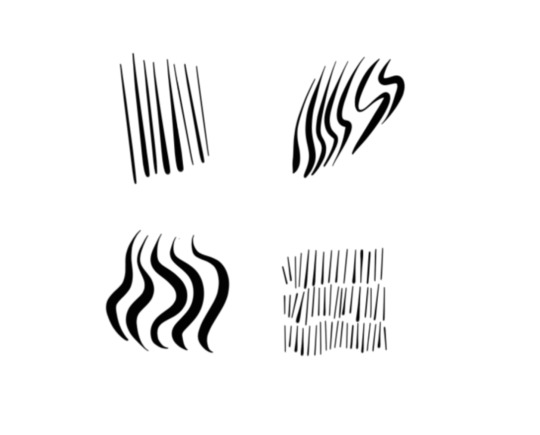
≡≡≡≡≡ ≡≡≡≡≡ ≡≡≡≡≡ ≡≡≡≡≡ ≡≡≡≡≡ ≡≡≡≡≡ ≡≡≡≡≡ ≡≡≡≡≡ ≡≡≡≡≡
Digital 01:
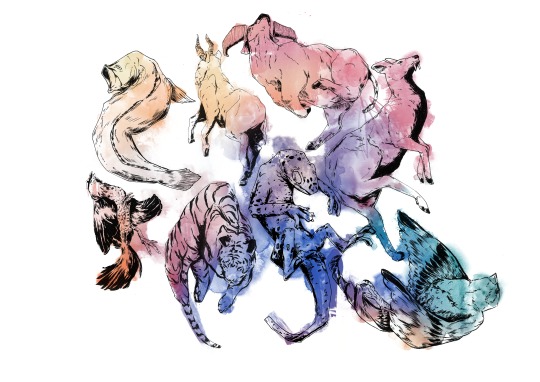
Digital 02:
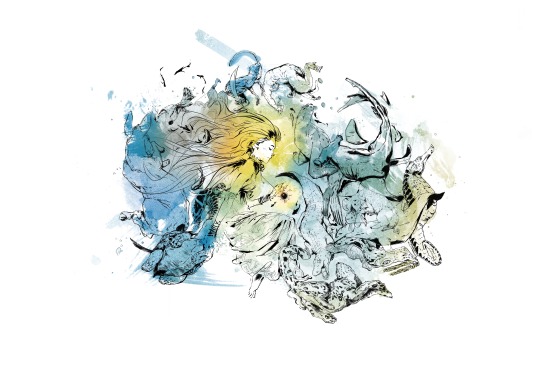
≡≡≡≡≡ ≡≡≡≡≡ ≡≡≡≡≡ ≡≡≡≡≡ ≡≡≡≡≡ ≡≡≡≡≡ ≡≡≡≡≡ ≡≡≡≡≡ ≡≡≡≡≡
Digital 02: Process
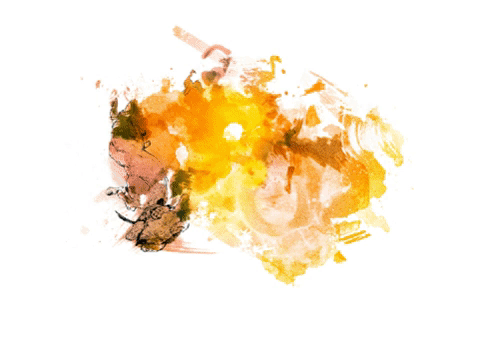
1. I have always found that beginning these blob doodles are the most diffucult for me. Perhaps because it takes me a little while to really get into the flow of continously seeing images in the randomness.

2. I began from the left, slowly working my way to the right and the top, since I felt that I had more clear lines to go from being around the edge of the paint.

3. Eventually I braved it and went right for the middle of the piece. This was the turning point for me in the process of doing this. It enabled me to truly let get, have fun, and not feel intimidated and nervous to do the next doodle.
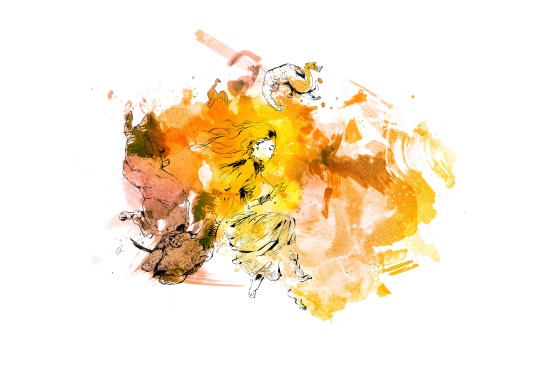
4. This is when I began drawing creatures of the sea, slowly building up a story/narrative.
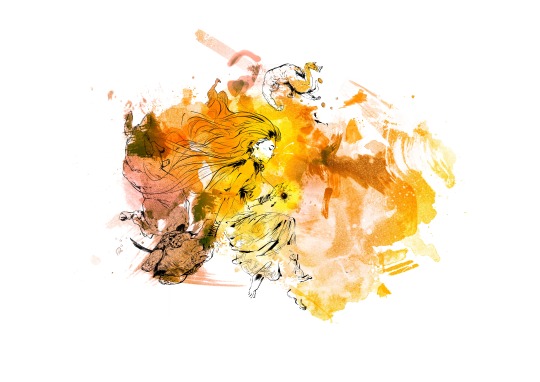
5. I don’t actually remember what I was even thinking at this point anylonger- I was simply just letting the pen guide me around the canvas; letting it all flow together however it felt as to do so.
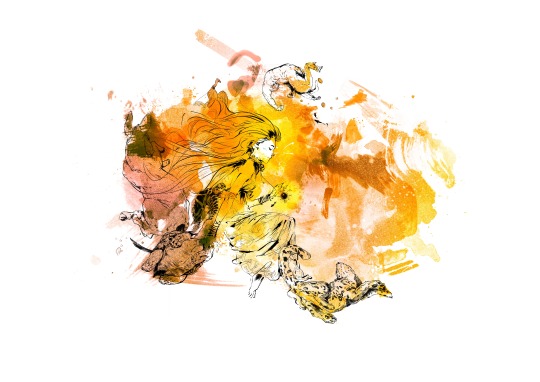
6. I began to delve into the little details. I felt as if they would add to the general flow of the piece; being busy, yet in a manner that lets your eyes wander with curiosity.

7. I was now moving on to doing the right side of the piece. I had a little more trouble visualising the top right corner, so I did that last.
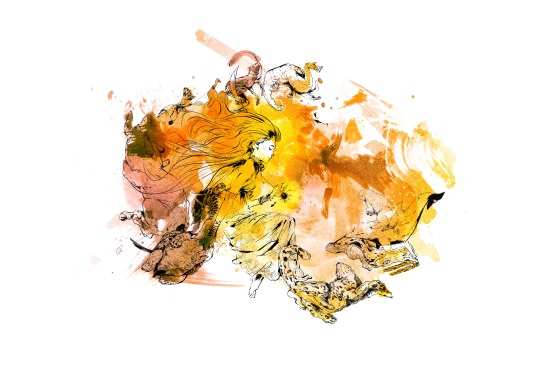
8. At this point I felt a little stuck as to what to do, hence it being, yet again, dedicated for adding some more little details here and there.
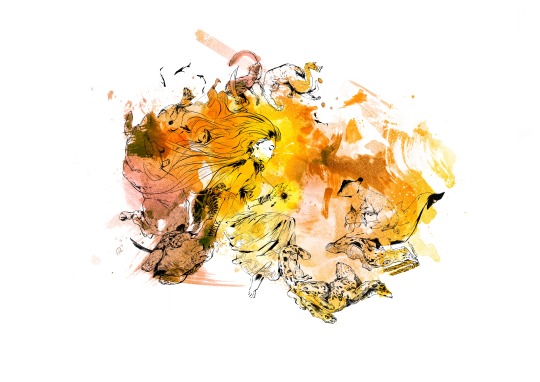
9. Eventually I overcame the frustration I had built up and took to do the right side of the artwork.

10. I tried to convey motion and flow by the way the animals are positioned and posed, trying to make it calm in the middle where the girl is, and then busy/chaotic the further away you get from her.

11. This second to last step was, again, for adding detail. I wanted to fill up any bits that I felt appeared too empty and spaced out, so to no disrupt the feeling of flow in the painting.

12. With the inking done and rendered to my satisfaction, the last step was to play around with colours.

≡≡≡≡≡ ≡≡≡≡≡ ≡≡≡≡≡ ≡≡≡≡≡ ≡≡≡≡≡ ≡≡≡≡≡ ≡≡≡≡≡ ≡≡≡≡≡ ≡≡≡≡≡
Digital 01: Colour variations
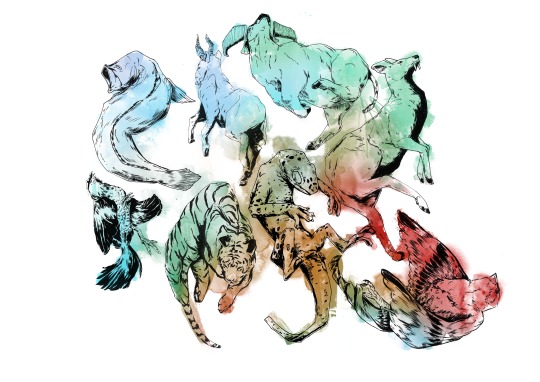
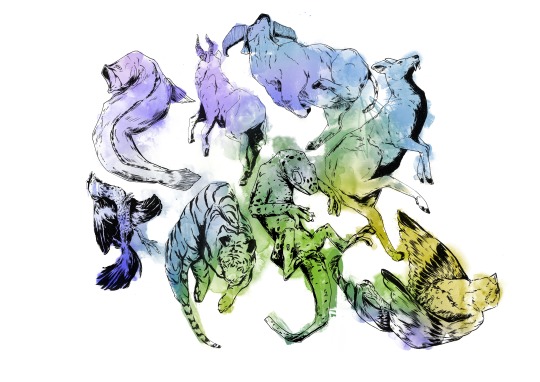
Digital 02: Colour variations
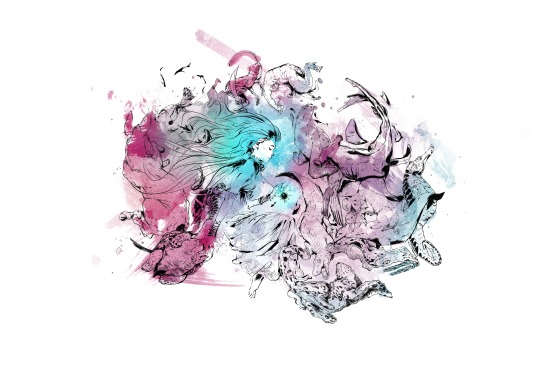
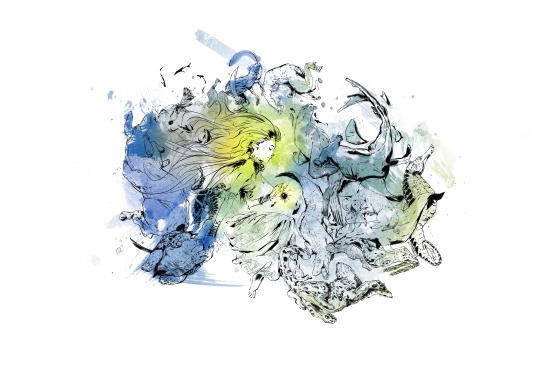
04: Scan/photograph and upload to Moodle.


≡≡≡≡≡ ≡≡≡≡≡ ≡≡≡≡≡ ≡≡≡≡≡ ≡≡≡≡≡ ≡≡≡≡≡ ≡≡≡≡≡ ≡≡≡≡≡ ≡≡≡≡≡
𝕱𝖎𝖓𝖆𝖑 𝖗𝖊𝖛𝖎𝖊𝖜 𝖆𝖓𝖉 𝖗𝖊𝖋𝖑𝖊𝖈𝖙𝖎𝖔𝖓:
Which of these words would you use when discussing the work of Will Barras and your own art pieces:

I would most definitly use;
Organic/Fluid
Figurative
Automatic
On top of these I would probably add;
Harmonic
Dynamic
Epochal
Visionary
Can you construct a comparative sentence/paragraph using at least 5 of these words. What are the differences and similarities between the works you have created. What conclusions did you make about this experimentation?
2 notes
·
View notes
Text
𝕻𝖔𝖘𝖙 𝖎𝖙 - 𝖈𝖔𝖒𝖎𝖈 𝖜𝖔𝖗𝖐𝖘𝖍𝖔𝖕 | 24/03/20
Since we are now all self-isolating, we are receiving all of our school work/homework over Moodle and Moodle Forum. For today, the task is to dive into a workshop called “Post It”.
vimeo
Attached was the following text written to us by our teacher:
“Morning folks.
Day 2 of lockdown and I thought I would post an activity that we can all get involved in. Basically, this is a fun workshop that looks at the theory behind how comic book narrative works.
What I want you all to do is use the video (pausing on each slide/task) and imagine I am going through it with my monotone drawl. Basically, if we all take part an upload something I will put together some group comic pages, that we can all be proud of!
All you need is some post-it notes (failing that make some small squares of paper) a sharpie, fineliner, pencils, ink if you have it. Then some resources, books, photos on your phone, your imaginations.
Follow all of the tasks and work the workshop through. Your goal is to upload your post it comic book panel/s by tomorrow morning. I have attached the PDF of the video too. Ask me any questions and I will try and give you feedback as we go through the challenge. I will hold a review session on Thursday.
Good luck team!”
𝕿𝖍𝖊 𝖜𝖔𝖗𝖐𝖘𝖍𝖔𝖕:
Aims of this session:
Make paneled illustrations based on observations and ideas generated from discussion and sketching.
Create at least 6 drawn and inked post-it note panels, with each one based on a different idea or subject.
Build a non-sequential “comic” using these panels
Make a group comic with everyone else’s panels
Compare the results and reflect
explore & discuss the theory of how we make sense of the world through various psychological elements (Gestalt theory) using comics as a vehicle to do this.
Task 01 – Reach & Sketch
“In order to stimulate ideas for your comic panels, you will need to generate sketches based on some visual prompts, this may be something you already have or you can use the starter topics below. Really there are no bounds here so the content of your panels could be anything you like, but having a place to leap from is always a sound approach. Spend 15 minutes doodling on each of the following topics, trying to communicate your ideas as simply as possible:
Objects & tools
Icons of inspiration
Characters & alter ego’s
Motivational words & wisdom
Emotions and expressions
Weird & wonderful
Use observations, people around you, old photos, a scene from the movie you watched last night and tap into that imagination!”
I began by putting on some music and simply just go at it, sketching whatever first came to mind when I looked at the prompts above. Eventually, I was left with some rough sketches scattered across a page;

01: Objects & tools
I was unsure of what precisely to draw, as I hadn’t warmed up prior to doing this workshop; but I saw a pile of chains outside the door from where I was working; thus this became the first thing I drew.

02: Icons of inspiration
The first person that popped into my mind as a source of inspiration for me was John Murphy (or just Murphy for short) from the TV series “The 100″. I have never connected as strongly to any fictional character as I have with him. It has gotten almost silly since a known party trick of mine is to practically cry on command if anyone does as much as show me a picture of him or say his name; but with that, It just goes to show how much of an impact his character has had on me over the years. He is most definitely part of the reason that I am even here today – his will to forever survive, no matter how much bullshit he has to go through, has been incredibly inspiring for me. I referenced this from an old piece of fan art that I did a few years back;

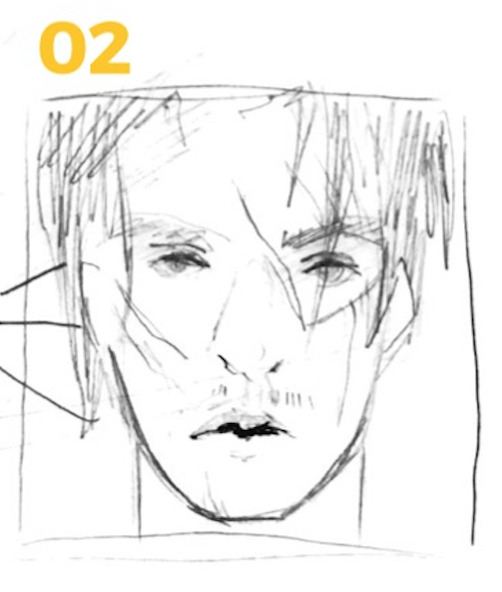
03: Characters & alter ego’s
Again, I simply drew the first thing that popped into my mind; which for this prompt was sort of viewing myself from outside my own body. (?) I drew myself as a wolf for no apparent reason besides that I creates me as a “character” rather than myself. The alter ego part steps in where I thought about the way I present myself vs who I really am. I may be this tough-looking guy (wolf?), but in reality, I’m no tougher than anyone else. I drown in my own thoughts constantly; often making me feel so worthless and horrible that everything almost seems to be sinking silently.

04: Motivational words & wisdom
This is a quote taken from one of the seasons of “The 100″, where Murphy has a short conversation with another character from the show called Titus, a guy that imprisoned him and tortured him for days before he managed to escape;
Titus: "You do not belong here."
John Murphy: "Really? Why does my blood decorate your floor?"
– in Stealing Fire (season 3)
05: Emotions and expressions
I feel as if this is an emotion I feel quite a lot. Anger, stress, despair, pain, envy, sadness; being so tired of everything constantly piling up to then fall back down again.

06: Weird & wonderful
Honestly, I’m not sure where this came from in my mind. Possibly it has some ties to the previous sketch (05) since it was more of an emotionally driven drawing; the character is hidden away by a darkness that they have put on themselves (the jacket/hazmat suit/coat?”, but they are holding something light in their hands- like a light orb; or perhaps it’s something more hostile and sinister, sharing the appearance of something bright and warm.
Perhaps the light orb is really a light anomaly (when properly identified, light anomalies are said to be able to potentially be the energy of a spirit transforming itself by use of the energy around it.) disguised as something safe, but in reality, it might of something demonic or a poltergeist (poltergeists are spirits with energy levels so high that they can physically interact with the world that we know of).
It’s really just up to anyone's interpretation.
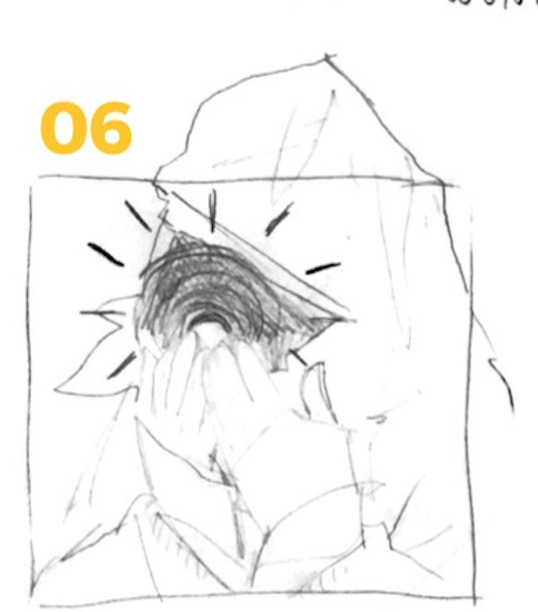
Task 02 – Define parameters
“Once you have created a selection of sketched ideas across a range of topics, take your post-it notes and draw with your fine-liner a loose border about 4-5mm in from the edge of the paper.
That 4-5mm of blank space is called a gutter. The place outside of the frame, where time and imagination, is at its most fluid.
Bordering a panel gives you a range of options of how to compose your image inside of it; draw in freehand or trace over one of your sketches, lining out the details with your black pen.
Composure and consistency are useful here but experiment with your approach to calligraphy and purpose of your line-work.”
I wanted my linework to feel delicate although the imagery isn’t all quite as such; creating a sense of juxtaposition between the relations of the context and the linework, so this I why I used a 0.35 fineliner.
Since I had no post-it notes, I cut out squares of white paper. After this, I traced over the sketches I had done earlier by pushing the sketch and “post-it note” up against a sunny window.
After finishing the tracing as well as the borders (to create the gutters on each “frame”); this is what I was left with:
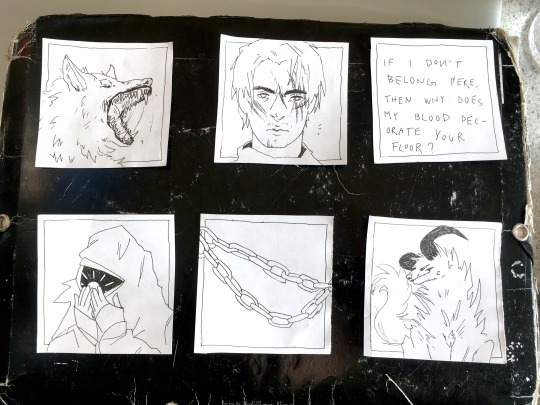
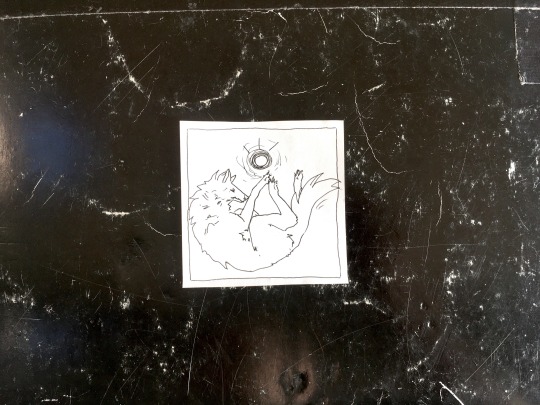
I am very happy with how they all turned out, especially after they have been inked with a fineliner- It really makes them all tie in together; although each of them is based on separate prompts.
I scanned them all in, the result of this shown below:
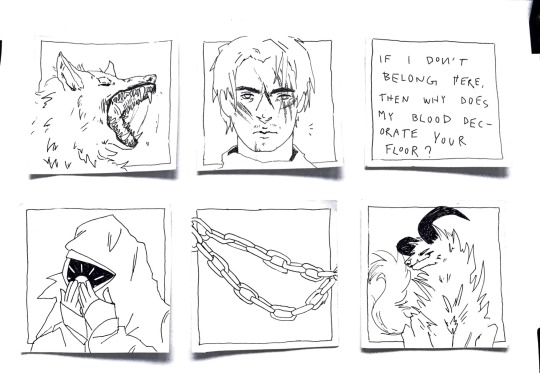
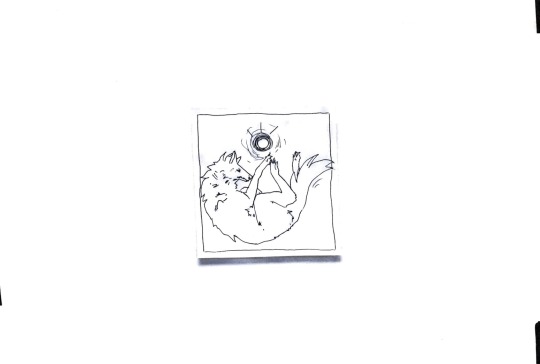
Task 03 – Display & arrange
“Once you have created at least 6 post-it panels, from a range of unrelated subjects, arrange these in no particular order on a blank page in your sketchbook (or a large sheet of paper if necessary).
Photograph this arrangement on your phone considering what your brain tells you are the overall meanings of this arrangement. Rearrange the sequence, and see if that meaning changes, record any thoughts or ideas about each sequence in notes to review later.
Now upload one of your panels up to the forum. We can then create a group comic, by mixing them all up. Try this at home too if you have photoshop?”
I have already done the random arrangement of the post-it comic panels, as they are shown above. But what does it tell me? What story does it create in my eyes? Below is my interpretation of what the comic portrays:
Betrayal
The wolf spirit raged in anger, for he had betrayed the realm, crossing barriers no mortal was to ever dare.
“Mortal fool- you do not belong here”, the spirit barked out as if to scare the human away with nothing but one's voice.
“If I don’t belong here... then why does my blood decorate your floors?” He answered in a bitter tone.
“You are nothing but a fool for what you have done! You deserve nothing but–”
A sudden silence overwhelmed the spirit and with the silence, the body of the spirit slowly disappeared into nothingness... creating an orb of light. It floated hopelessly above the floors for a while, until it descended into the hands of a stranger, shadowed by a cloak. Behind the cloaked figure, the sound of chains rattling echoed, until a horned wolf made its way next to the strangers' feet.
“You have done well, human. This... spirit; was a traitor– but no more will it pester you.”
“Who are you?” the human asked, his wounds still bleeding from his previous fight.
“A god. None that your kind has ever heard of. I am Death's brother, Hypnos.”
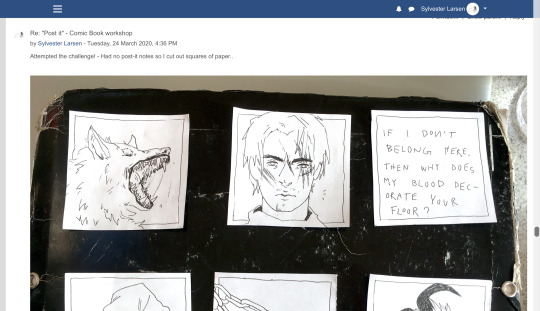
I also posted all of the frames on the Moodle Forum. ↑
Task 04 - Conclusions
“Look at the comics you have created and then read the following text written by comic book analyst Kaitlyn McCafferty:
“Non-sequitur transitions are constituted of a series of images that are seemingly unrelated to each other in any classic narrative form. Non-sequitur transitions are the most cognitively disruptive; they are the most uncomfortable. Though the curator of these panels may not have had a specific narrative in mind, the viewer will try to draw associations between the images shown. This irresistible human tendency to put elements together to form a complete whole can be explained by Gestalt psychology, which explores the notion that human perception of a whole subject is based on the sum of its parts.”
Answer the questions below and present your work and other people's work on the blog:
Do you understand the theories being discussed here?
The Gestalt theory; I understand that this theory focuses on the human condition and needs to find order and pattern, and in this instance narrative amongst images. Gestalt explains that it is common to take a more holistic approach to this, by taking into account the individual parts of the narrative, in this instance the individual images, and only then decide the narrative. In many ways, this task has allowed us to explore what happens when rather than following these theories or playing into human tendencies to expect order, to see what human imagination can create on its own when order is not present.
Why is this interesting?
This task is interesting because it opposes conventional narrative, and forces the observes to use their imagination to try and find patterns amongst the random images, even when no set pattern exists. This, in turn, proves invaluable, because it furthers our understanding of human psychology and the endless potentials of our imaginations to create an infinite amount of stories and narratives, based off of only one set of images depending on which order they are placed in.
How could you use this to help with your own projects?
It always helps knowing how people work psychologically to predict what an audience would find interesting and intriguing say, for some character design. It is already widely used in our society; for example, in books, TV series or in a series of films they often end them on a cliffhanger with the purpose that you will want to continue watching/reading to find out what happens afterward. Our brains instantly start trying to figure it all out, attempting to tie everything together with the information given, but still, we want to be reassured.
Update 1.1:
After looking at some of my peers’ work, I have decided to try and replicate the look of “post-it notes” a little better by adding colour to them. Although I like the minimalistic black and white look, I feel as if it doesn’t completely match what this entire workshop was about; sparking ideas by doing comic-like panels on post-it notes.
Below are some of the work my peers did that I had a look at;
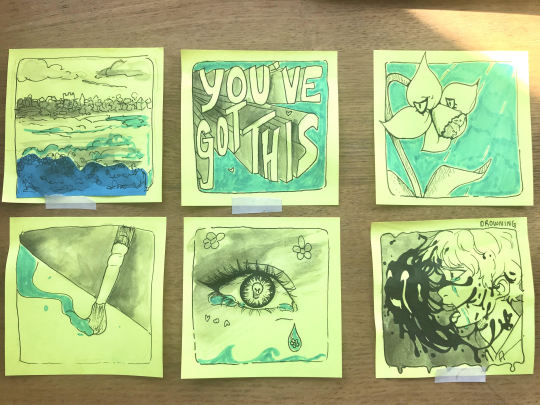
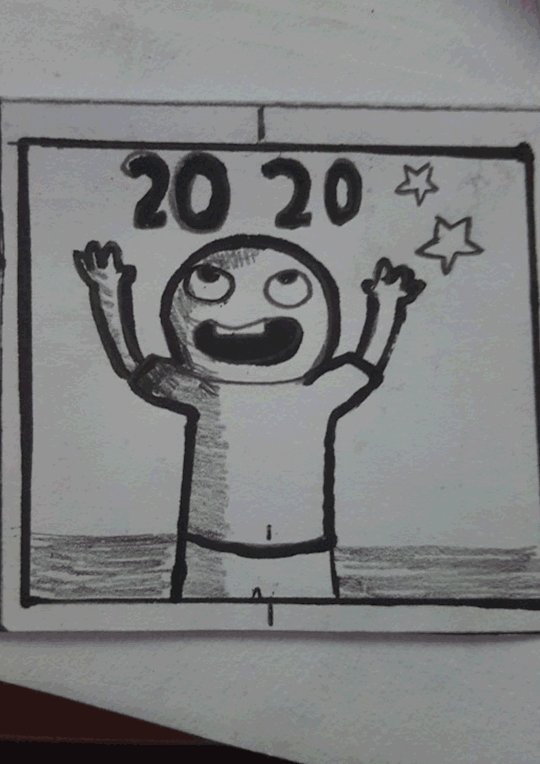

So, I took the scanned files of my “post-it notes” and loaded them into Krita. I set a layer to multiply, allowing me to add any colour I wish to each note. I did this for both the scans;

And finally, here is the finished product!:


Here they are loosely animated together in the same order as above;

And here is another version of that same gif;
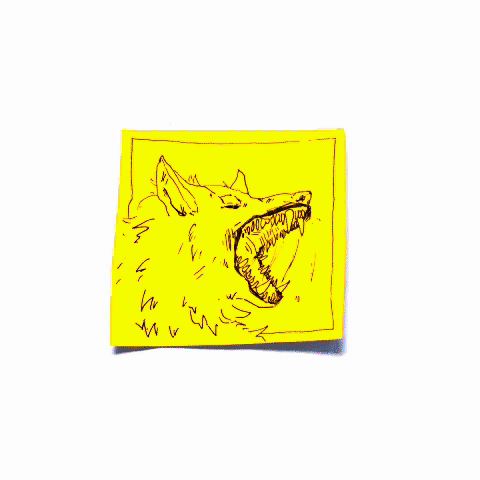
Update 1.2:
25/03/20
Our teacher further set a challenge to develop this workshop further;
“Try and read the 'comic', and then consider Scott McCloud's ideas....does this nonsequential set of images "work" together. What is the result of grouping them? Do narratives start to appear?
If you have done 6.....now let's do 12? Remember details are everything. Take your time. We will review Thursday afternoon.
“Here's some pointers for all of you:
01: Work on the stylisation of your written text (typography) as this is vital part of comic book panels
02: Develop and use background tonality more, if you have it water down some ink and try and build a sense of depth in the frame
03: Use hatching/pointilism and other mark making to support this sense of depth in the frame even just solid black fills will work (See the work and get inspired by the work of Mike Mignola/Adrian Tomine/Aiden Koch to support)
Keep going folks, let me see your group comics too, take a panel from everyones and put them together in a random sequence. Test the theory!”
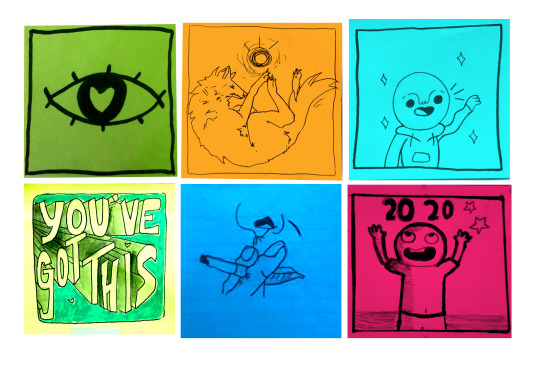
(Matt Tankard / Sylvester Larsen / Bill Martin / Emma Aspris / Bertie Brocki / Matt Tagliarini)
What does the above sequence of post-it notes make me think of narrative-wise?
The first thing that popped up in my mind was; this is part of a dream sequence. The colours, always changing with the imagery that one's brain makes up on the go. I feel as if it closely portrays dreams I have had in the past; all scattered around with no direct links to each other; as if they are all separate glimpses of different dreams. It definitely reflects the nature of surrealism with how unpredictable it appears as a collectible.
I decided to then make one of these random post-it note sequences myself, using stuff that my peers created. Below is how that turned out:
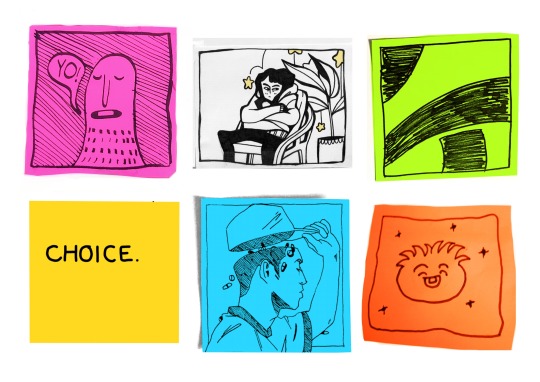
What does the above sequence of post-it notes make me think of narrative-wise?
After looking at it for a while, I established an idea of what this little sequence could depicting narrative-wise.
It begins at the upper left with someone saying “Yo!” and the next frame showing perhaps yourself or another random character. You/They are in a grumpy mood- feeling like there’s nothing much to do and everything feels boring. So the someone leaves you/them with a choice - Are you/they going to take the drugs, or not? It’s now between feeling the same boring stuff, or feeling something you/they have never felt before. You/They answer “Yes”, and so you/they suddenly feel an odd rush of happiness, warmt and colour.
Don’t do drugs. They’re bad. This was just what initially came to mind for some reason.
- - -
Now for expanding the number of comic frames from 6 to 12, whilst keeping the pointers we were given in mind.
To expand on the prompts, I have decided to randomly generate some words by using this website, a random word generator, putting the settings to the following:
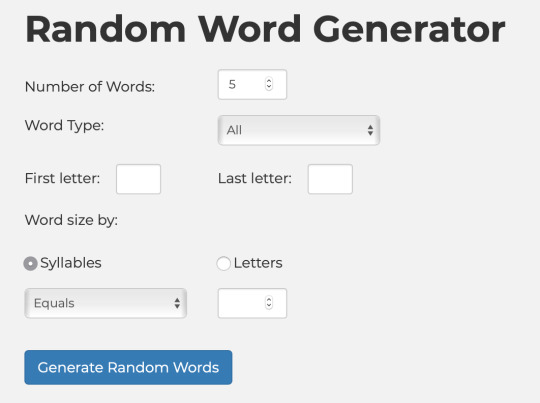
I generated the following 5 words:

I looked up the definitions of each of these words, giving me the following to work from:
Inhabitant:

Spoil:

Dose:
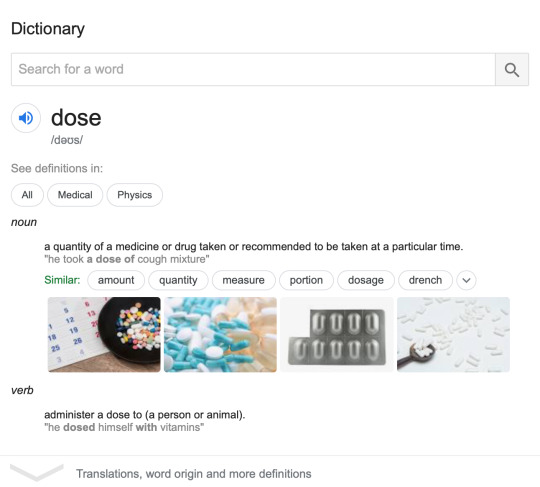
Reinforce:

Generate:
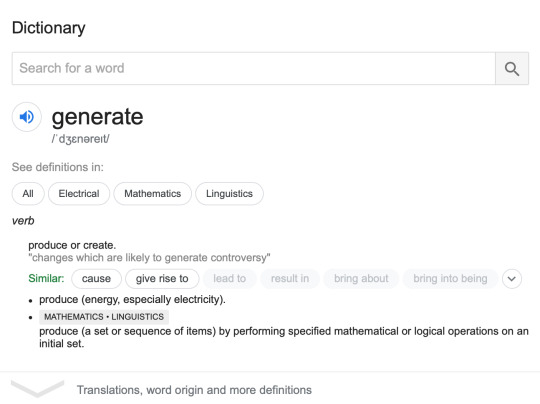
Now keeping the definitions of each word in mind, I attempted to illustrate my interpretation of them, using the same process as previously:
I only did 5 this time around, since I did 7 the last time around, making 12.
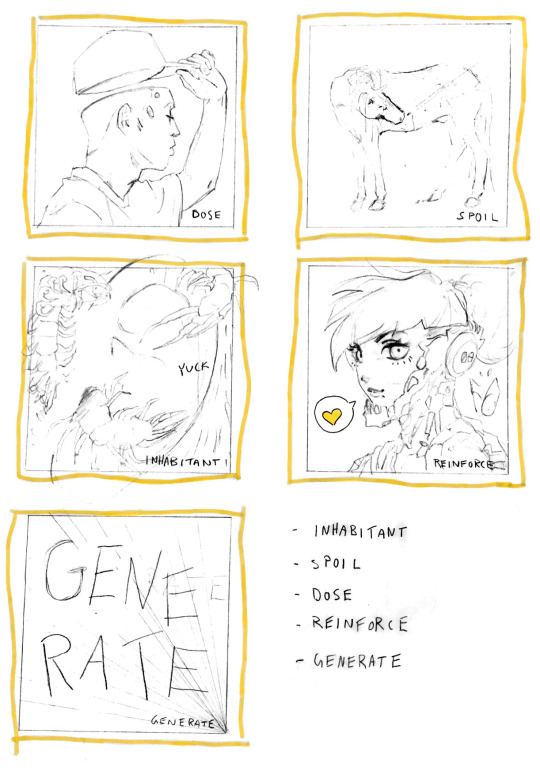
Dose:
For this one I imagened it being related to drugs. At the time of drawing it, I was listening to some rap music, and it made me think of how it lately has become a trendy thing to take drugs such as xanax. - it’s basically based on how many young people gradually only have drugs on their mind.
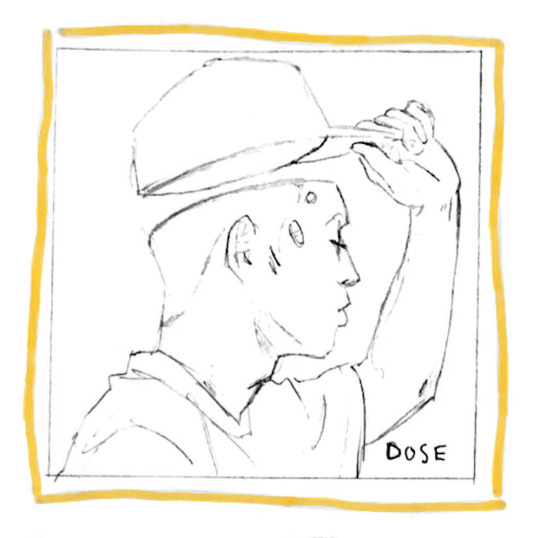
Spoil:
I interpreted this as something being damaged. - I wasn’t sure what exactly to do, so I eventually just decided to draw a horse that has been shot with some arrows.
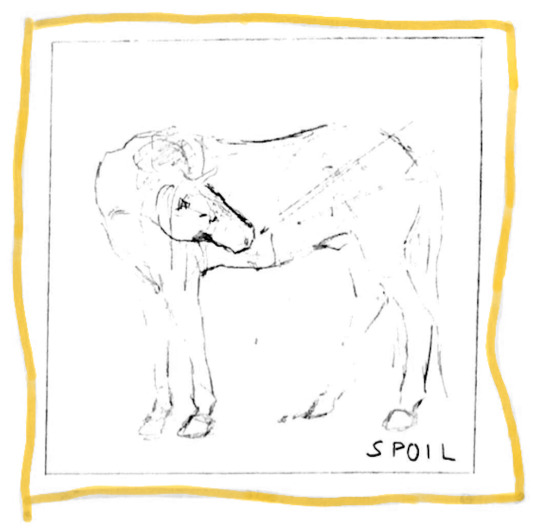
Inhabitant:
The inhabitants in this little frame are centipede bugs, crawling around a humans ear. I felt as if it would fit the meaning of this word well, as it indicates that these inhabitants are not welcome and don’t belong there.
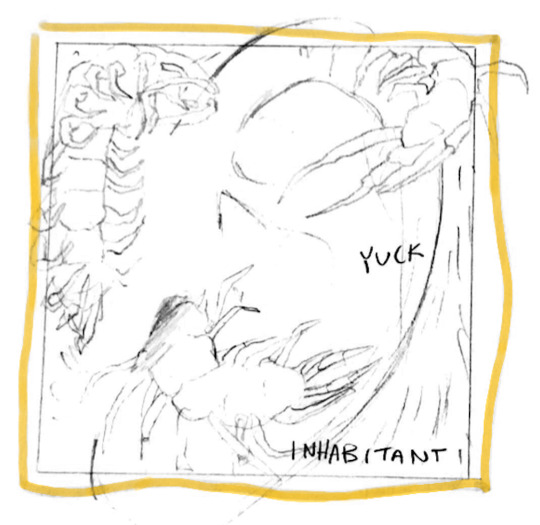
Reinforce:
For this frame, I interpreted the word “Reinforce” as something being supported, so I sketched a mech girl where the reinforced bit is the metal suit she is wearing.
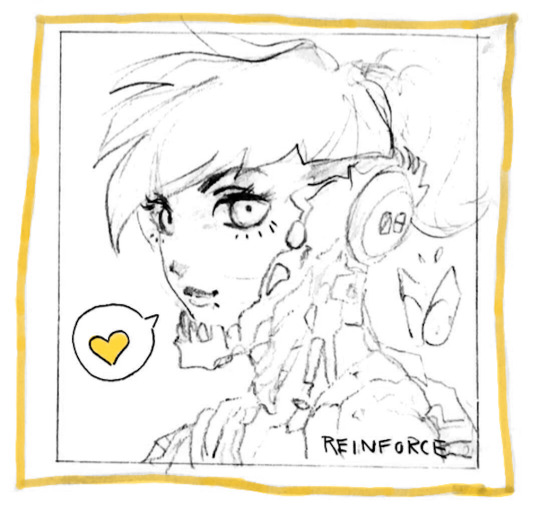
Generate:
For the last frame, I went a little more simple and took the route of just doing some typography, after reading that our teacher asked us to do some more interesting looking quotes/type, so I gave this a drop shadow after going over it with the fineliner.
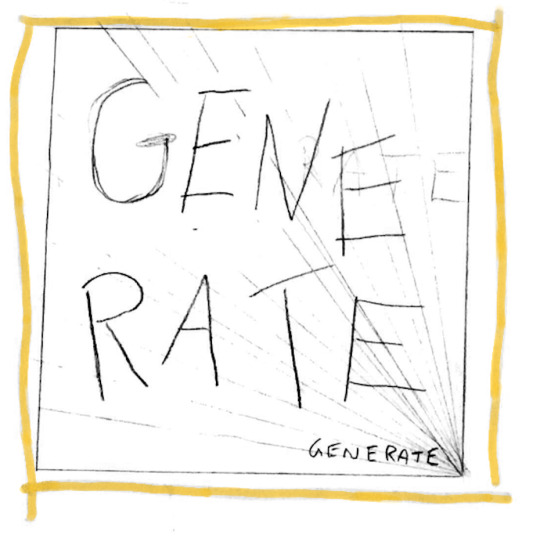
As I did previously, I traced each frame up against a window with a fineliner, being the same as I used the last time.
After this, I cut each frame out and scanned them in. I added the same yellow colour to them to make them match, but also to make them feel more like real post-it notes;
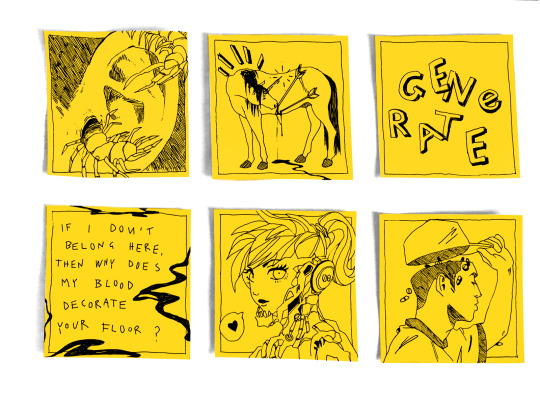
I eventually found that I had lost the post-it note for the first quote I did, so I redid it, although I then found the original again afterwards.
0 notes
Text
𝕯𝖗𝖆𝖜𝖎𝖓𝖌 | 18/03/20
Tasks:
1. Generate a list of adjectives to describe motion:
Dash, alacrity, acceleration, velocity, quick, haste, gait, brisk, pace, momentum, rush, eagerness, rate, tempo, celerity, fleetness, hurry, swiftness, flit, dart, bolt, spurt, dynamism, alteration, change in action, flow, evolution, scuttle, progression, shifting, evolving, strut, static, shudder, drift, cronic, plodding, strike.
2. Select an action/motion/emotion to explore through mark-making.
Dash, alacrity, acceleration, velocity, quick, haste, gait, brisk, pace, momentum, rush, eagerness, rate, tempo, celerity, fleetness, hurry, swiftness, flit, dart, bolt, spurt, dynamism, alteration, change in action, flow, evolution, scuttle, progression, shifting, evolving, strut, static, shudder, drift, cronic, plodding, strike, unfolding.
0 notes
Text
𝕮𝖑𝖔𝖘𝖊 𝖊𝖓𝖈𝖔𝖚𝖓𝖙𝖊𝖗𝖘 | 16/03/20
College announcements:
There will be e-mails coming through soon, so make sure to check frequently.
Advise if the college does close due to COVID-19; check the school website.
What have we done so far, now being two weeks into our FMP, and what should we be able to evidence?
We have done the following:
The theme of “Encounters”.
Starting points reflecting on keywords and terms from previous projects
Developing portrait illustrations and basic artist research (simple analysis and quote)
Primary Observation of objects and working collaboratively in drawing
Proposal writing and establishing research/start points
Elective/Workshop practice and developing technical skills
Checklist for the end of week 2:
Mind map of the Encounter brief linking together previous projects with current themes and ideas (production file)
Reaction to brief on the blog with some initial thoughts and ideas
FMP handbook up to date including any tutorials or tasks completed
Visual examples of the stages of “icons” workshop (Printed and then examples of artist work
𝕮𝖑𝖔𝖘𝖊 𝖊𝖓𝖈𝖔𝖚𝖓𝖙𝖊𝖗𝖘
Revisiting pose to pose animation and morph animation.
Our aims & objectives:
To review and apply the elements of visual language to illustrated & animated ideas
To experiment with working from a reference to develop imagined responses to a specific idea
Visual language
We did a mindmap, trying to trace back to what we have been taught about visual language.
What else do we need to consider?
Meaning, purpose, and function
Design elements, balance, proximity, alignment, repetition, contrast, space, hierarchy, composition, layout, consistency
We then looked at two different examples of artwork as a task;
Task: Looking at both of these images, describe what you can see in terms of the visual language elements (rough textures/bright colours/contrasting tones). Then decide as a table what you think those elements together communicate, what do you think the work/artist is trying to say? why do you think this?
Katsushika Hokusai - Poem by Sarumaru Dayû, 1835

Colour: Muted, soft, earthy, balanced hue, pastel
Line: Delicate, thin, careful. It contributes to the calmness that the picture portrays.
Form:
Shape: Organic, natural. It looks tranquil as if the people have been through the countryside, working, seeing the city where they live to come home.
Will Sweeney, Temptation

Colour: Contrast, warm and cold, bright, bold, juxtaposition. Communicates conflict. It reminds me of pop art–
Line: Bold, heavy, dense but detailed.
Form:
Shape: Mechanical, jagged, sharp. It feels busy and sort of unnerving.
We are going to focus on Hokusai and Sweeny for the inspiration for today.
Hokusai: Observation - reference, observational drawing, looking - drawing - looking.
≡≡≡≡≡ ≡≡≡≡≡ ≡≡≡≡≡ ≡≡≡≡≡ ≡≡≡≡≡ ≡≡≡≡≡ ≡≡≡≡≡ ≡≡≡≡≡ ≡≡≡≡≡
Task 1: Initial encounter
Based on the principles of Hokusai’s sketchbook (simple renderings and characterization from observation), pick a photographic image of a person from the collection of found photographs.
Caricature your source and refine over the course of multiple sketches (5-10) and drawings (Re-drawing will be key here). You can choose to just do the head of the character or the full-body depending on the source.
Finish your drawing by producing a final linework version using fine-liner to ink in your lines etc.
≡≡≡≡≡ ≡≡≡≡≡ ≡≡≡≡≡ ≡≡≡≡≡ ≡≡≡≡≡ ≡≡≡≡≡ ≡≡≡≡≡ ≡≡≡≡≡ ≡≡≡≡≡
Task 2: Mutation
Based on the eccentric characterizations of Will Sweeney and the following premise develop/mutate and evolve your character.
Imagine that Alien life forms have been living among us for 1000’s of years inhabiting the bodies of human hosts, Your job is to now render your human character into alienated version, adding whatever details/flourishes and changes you like, whilst still retaining some of the original qualities of size/scale/structures and the initial characterization.
This will be important for the next stage of metamorphosis.
≡≡≡≡≡ ≡≡≡≡≡ ≡≡≡≡≡ ≡≡≡≡≡ ≡≡≡≡≡ ≡≡≡≡≡ ≡≡≡≡≡ ≡≡≡≡≡ ≡≡≡≡≡
Task 3: Metamorphosis
Using the two versions of your character (Human / Alien) you must now try to create a morphing frame by frame animation using the two versions as your key frames/positions.
Think about how you did this before?
Are you going to work use subtraction or addition?
Will it be a mix of both approaches?
How will you tween consistently?
How many frames will you need?
≡≡≡≡≡ ≡≡≡≡≡ ≡≡≡≡≡ ≡≡≡≡≡ ≡≡≡≡≡ ≡≡≡≡≡ ≡≡≡≡≡ ≡≡≡≡≡ ≡≡≡≡≡
Definition of Terms within frame by frame animation:
Key poses (Keys): They are the key positions of your sequence, essentially the book ends (1st and last frame/body position, etc)
Extremes: These are frames/poses that are the extremes of action (leaping then landing/leaning/weight shifts/expression/facial changes etc) within the range of the key poses.
Inbetweens/Tweens: These are the frames that get you between the extremes, more or fewer tweens will dictate the speed/smoothness/timing of the animation. You need to review this as you animate.

Review & Reflect on ‘Close encounters’
Question and reflect on your process today, think about the following when writing your blog review:
What was the aim for today’s session?
Who did we look at for inspiration?
Can you find some of them and analyze examples of their work?
Can you compare them?
Can you describe your process in response to this research?
Considering the animations you made in term 1 & 2, how was this different?
Was this a harder process? If so why?
What is the potential with this process?
Can you set yourself an action based on the successes/weaknesses of your work today?
How does this now effect your ideas and
What developments could you do now for your own project?
≡≡≡≡≡ ≡≡≡≡≡ ≡≡≡≡≡ ≡≡≡≡≡ ≡≡≡≡≡ ≡≡≡≡≡ ≡≡≡≡≡ ≡≡≡≡≡ ≡≡≡≡≡
Tutorial:
Intellectual property (IP) is an idea that one person has and has copyrighted.
Loretto, a graffiti artist in Paris and France, a lot of political work. Banksy has taken inspiration from his work since Loretto did this style of grafitti art long before Banksy.
A lot of work that Andy Warhol has done has been copied and strongly inspired; Andy was inspired by another artist; Roy Lichtenstein.
It is important to stay protected when one creates something, as well as being inspired, not copying!
We watched some videos on Intellectual property to get a better understanding of it;
youtube
If you want to bring other people one for a bigger project that you cant complete yourself alone, it is very important to make it clear what their job is. If a written contract and/or lawyer isn’t an option, recordings and keeping track of everything agreed on between the people working together as evidence for ownership.
-
We watched a second video, a poet talking about how he makes his work as well as the trail of the research before he comes up with the final product.
youtube
We watched this video for the reason of understanding what the difference is between stealing, copying and being inspired.
0 notes
Text
𝕴𝖈𝖔𝖓𝖘 𝖜𝖔𝖗𝖐𝖘𝖍𝖔𝖕𝖘
For this workshop, we focused on creating artwork to fit the following aims & objectives:
To create iconic portraiture using simple mark-making techniques and some traditional mediums
To develop portraiture using an integrated process of both traditional and digital approaches
To make connections to research as we begin our final project
To accomplish this, we were told to pick an iconic artist from history at random, using cards showing a variety of these famous artists from a card game. My first card was René Magritte. Funnily enough, we studied his work in our first brief, (Pick & Mix) where we looked at the surrealism movement which began around the beginning of the 1920s.
The second card that I picked was of Banksy, well known for not being known. I liked the idea of doing him as a portrait for the reason being that no one knows who he is, meaning no one knows what he looks like, but I was advised to go with René first for this task, and then possibly go back and do Banksy afterward if I wanted to.
Before starting, we had a short introduction to how we are going to be using the different mediums for this workshop, including the following techniques/mediums; paper carbon transfer, traditional tracing, ink washes, and mono-printing;
youtube
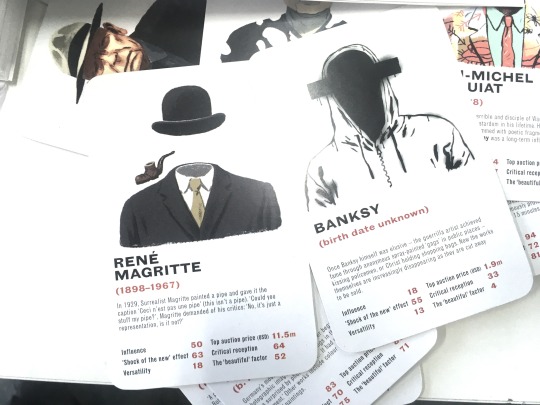
Icon 01: René Magritte
Who were they? What were they well known for doing/what made them iconic and why did they create the work that they did? What made them go down the road of the surrealistic movement?
So, to the task at hand–
This is the reference that I chose to go with for René (which I printed out in A4 scale):


There were a good handful of portraits to chose from of him, most of them being from his older days, but I chose this picture of him for a few different reasons. One of them being that I find myself to be able to relate to it better than any of the other pictures, due to the fact that he is of a younger age in this portrait. On top of that, I find that it has a calming sort of atmosphere to it, which I found quite appealing when I first saw it as it stood out from most other portraits that I came across.
Tracing paper
The first medium I decided to have a go at was pen on tracing paper since I am familiar with it already. I didn’t want to jump into anything too far out from my comfort zone as the first thing I were to draw this day and at the same time, I wanted to ensure that I had a “layer”/drawing of the reference that was of some detail so that if I wanted to, I could go crazy with any of the other mediums since I would still always have the main silhouette to refer back to, making it readable no matter what.

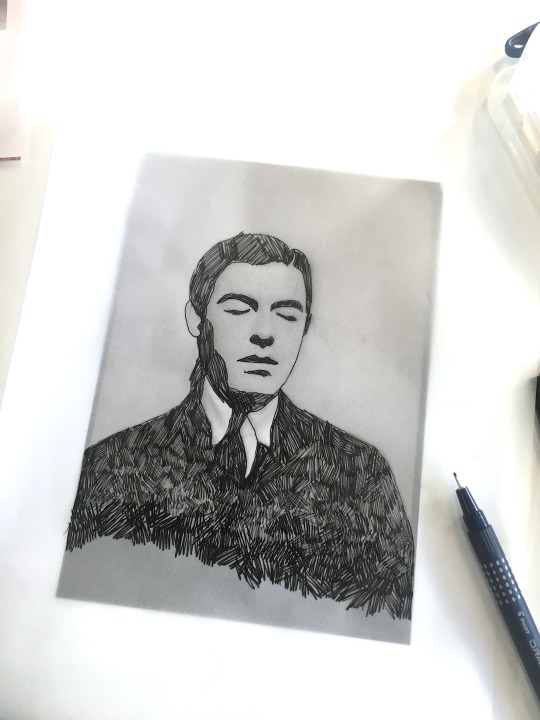
Here it is shown side by side:
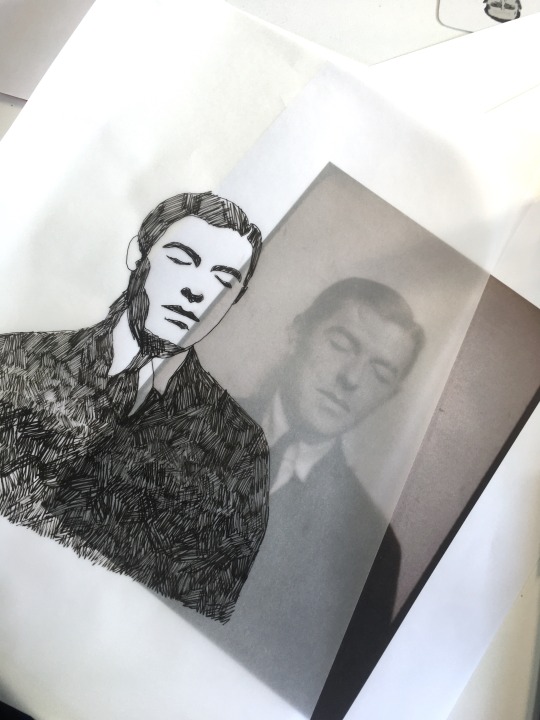

Carbon transfer paper
The next medium I decided to go for was the carbon transfer paper. Now, I have never used this myself prior to this workshop, although I have heard quite a lot about it in the past, primarily from online sources (other artists or companies selling this type of product). I used a pencil to transfer the carbon pigment in an attempt to replicate the texture and look of the traditional pencil stroke, which is one of my personal favorites texture-wise.
Mono-printing
The final medium that I experimented with for this first lesson was mono-printing. Like the carbon transfer paper, I too haven’t tried this prior to this lesson.
Icon 02: Banksy
0 notes
Text
𝖂𝖍𝖆𝖙 𝖉𝖔𝖊𝖘 𝖙𝖍𝖆𝖙 𝖊𝖛𝖊𝖓 𝖒𝖊𝖆𝖓?
A growing glossary for my confused brain, all being alphabetical.
A
Accidental: When speaking of something accidental, most often you’d associate it with making a mistake. In art, that is an often occurrence; but it’s not always for the worse! Mistakes can force you to see your creation from a different perspective or make you have to think outside the box to cover it up/blend it into the rest of the picture. You might even end up liking your mistake as it is and choose to then embrace it.
Allegorical: Allegory is often used in art as a way to convey and symbolize a deeper moral or spiritual meaning such as; death, life, jealousy, hatred, etc.
Angular: This refers to some kind of shape, object or an outline having sharp angles and corners.
Animatic: Essentially it can be described as a moving story that is synced up to audio. In the animation industry, it is used to create a rough visual of the final product with the use of the voice recording that they have had their voice actors record. During this process, they can add and take away everything they feel like.
Animation: A series of linked images placed in a sequence to create the illusion of movement and life
Antagonist: They are the rival of the protag. A person who actively opposes or is hostile to someone or something; an adversary. They are often portrayed as characters with a dark background; an example of this could be an evil ruler that grew up in an abusive environment or something alike.
Archetype: This can be defined as a very typical example of a certain person or thing, often very generalising/stereotypes, but this is not how you would define archetypes in storytelling specifically. Archetypes can be defined as for example; the sidekick or comical release character (the jester), the mentor (wise), the innocent, the explorer, the hero, the lover, the ally, the trickster, the guardian, the shadow, the ruler, the friendly beast. Essentially, they are different roles.
Automatic: This is a way of tapping into the unconscious mind. When you create something using the technique of automatism, it means that you aren’t thinking about what you are drawing, have drawn and is going to draw next, you simply just let the pen and your hand do the work while your head is left to rest.
B
C
Chaotic: When referring to something being chaotic, most often you’d use this term to describe a piece of artwork, depending on how many individual aspects are put together on the “canvas”. In some cases, if the artist has a lot to say, it might end up affecting the way it turns out in the end; chaotic. If a piece of art is chaotic or feels busy, it could reflect something allegorical as well; a hidden meaning hiding in between all of the distractions.
Chattering: It generally means that each frame in a given animation isn’t lined up completely evenly; general imperfections are often very easy to spot once played back, but with practice, it can be avoided quite efficiently.
Clean up: This is part of the overall process of animating. It is especially often used in hand-drawn/analogue/traditional animation. In this workflow, the first (conceptual) drawings are called roughs, referring to how they are very loose and rough at this stage. Professionally speaking, when the director has approved of these roughs, this is when clean versions of these are created. This process is called clean up. The term of clean up can also be referred to as, for example, when you have done frames in ink and some of it may smudge in the process, you can scan in the frames and proceed by cleaning up the frames digitally.
Climax: A climax builds upon everything that has been introduced during the exposition and rising action. This is the moment of truth for the protagonist and the peak moment of the story. You know the plot is successful at delivering a good climax when the outer journeys and the inner goals of which the protagonist wish to complete click.
Considered: Opposite to automatism, considered art has been planned out before being done. Sometimes artists even go as far as planning out each line and colour before applying to the final product. This can be done by doing a bunch of tests and sketches, or by mind-mapping ideas beforehand.
D
Denouement: Denouement (resolution) is a fancy way of saying that the story is about to come to an end. At this point, all questions are resolved and answered; letting the reader.
E
Encounter: (verb) Unexpectedly be faced with or experience (something hostile or difficult). (noun) An unexpected or casual meeting with someone or something.
Exposition: This is where the characters of the story gets introduced alongside the story and plot itself. This is often the most difficult part to set up successfully, simply because you need to capture the readers/viewers/target audiences’ attention and have then clued in on what’s going on in the story, but this has to be done without completely spoiling the rest of the story. It is important to not mistake exposition and an info dump.
F
Falling action: So, what now? You’ve technically finished the story. Finishing a story after a climax or during one is what is known as a cliff-hanger. Cliff hangers work well in film series, but they don’t feel as satisfying. A way to see falling action could be as the old saying; “What goes up must come down.” Putting together any hanging threads not yet solved in the plot is done during this stage.
Frame by Frame: An animation will only work if key positions are lined up together. There has to be a start and a finish for it to be a successful frame by frame animation.
G
H
I
Illustration: When talking about illustration, it describes usually a drawing or an altered picture of some kind. It can also be referred to the act of illustrating; (creating, drawing, altering, etc.)
Inanimate: Doesn’t move or have any life to it. Lack of consciousness and power or motion. Not endowed with life and spirit. Some examples being; bricks; it comes alive if you throw it. inanimate things come to life.
Incongruent:
J
Juxtaposition: This is when you bring together two opposite things that may not naturally go together, go together; creating contrast.
K
L
Linework/Keyline: Linework can simply be put as a specific technique of drawing lines when talking about art. There are countless ways in which you can interpret linework, some of them being; bold, fine, scattered, clean, sharp, fluid, altering thickness, etc. - When talking about keyline, it can relate to linework as the planning part of linework. To give an example of this, it could be that you outline the image or shape of something, planning where the linework has to be placed; keyline.
Looping: Looping is where you have a sequence of frames that repeats infinitely. The first frame is the same as the last frame. It’s like an endless cycle. It’s a labor-saving technique for animation repetitive motions; walking, a breeze in the trees or running.
M
Model Sheet: When talking about model sheets (also known as a character board, character study or character sheet) it is mostly understood as a visual representation of a character to understand the poses, gestures and even the personality in animation, comics, and video games.
Mutated:
N
Narrative: This can be explained as the plot of a story. It most often includes characters and a setting as well as a person or narrator from whose point of view the story is told. It is generally speaking a spoken or written (to later be illustrated/animated to convey this story) collection of connected events. It’s how a story is told. Who? It is told to an audience. In the beginning, the scenario is set up. Why is a narrative different from a story? The story is a subjective opinion about what’s happening, whereas the narrative is more of an objectified version of that. Jack walks up the hill; story, Jack has mental problems, narrative.
Narrative theory: Exposition -> Rising action -> Climax -> Falling action -> Denouement
Neolithic: Neo means “new”, Lithic meaning “stone”- New-Stone (stone age/new stone age; creating something new from old stone)
O
Objective:
Organic: When something looks organic, it’s just another way of saying “natural”. Most often, an organic shape would appear fluid and have some imperfections to its qualities. A sharply edged shape would convey something manmade like houses or other solid manmade objects.
P
Primary research: Interviews, looking and studying imagery, galleries, museums, exhibitions
Primitive Art: The term “Primitive Art” is a rather vague (and unavoidably ethnocentric) description which refers to the cultural artifacts of “primitive” peoples - that is, those ethnic groups deemed to have a relatively low standard of technological development by Western standards.
*This term is usually not associated with developed societies but can almost definitely be found in most cultures.
Protagonist: This is the main character or one of the major characters in a play, film, novel, etc. It is not at all unheard of that the protagonist is a heroic figure for. They make the key decisions and experience the consequences of these decisions and actions. Protagonists usually go through a journey to learn and evolve upon themselves.
Q
Quest: A quest is a journey that someone takes, in order to achieve a goal or complete an important task. Accordingly, the term comes from the Medieval Latin “Questo”, meaning “search” or “inquire”.
R
Rising action: This is the moment where the plot and narrative beings picking up. Rising action is usually encouraged by a key trigger, which is what tells the reader that “now things will start to take form.” This key trigger is what rolls the dice, which then causes a series of events to escalate to then set the story into motion.
Rotoscoping: It is one of the most simple and accessible ways of animating regardless of the level of skill, aimed to create realistic sequenced movement. It is one of the simplest forms of animation and is also used universally. Rotoscoping is an animation technique that animators use to trace over filmed footage, frame by frame, to produce a realistic sequence of action and movement.
S
Secondary research: Book, documentaries, the internet, presentations, articles
Sequence: A sequence is a collection of something that is related to each other, put into a specific order to create motion, storytelling, feel, spark thoughts etc. It is used in animation, related to Frame by Frame.
Stop motion: Where you have a model or any animate objects and you move it a bit for each picture taken; when played back it should give the illusion of movement. The more frames per second, the more fluid the movement will become.
Storyboard: Storyboards are a sequence of drawings, often with some kind of direction and/or dialogue included within. They are often used for storytelling in film, television productions and comics/comic books.
Subconscious: In art, the use of one’s subconscious mind was inspired by the psychologist Sigmund Froyd and his many theories on dreams and the subconscious mind. To put it simply though, the noun subconscious describes a person’s thoughts, impulses, feelings, desires, etc. all of which are not within the individual’s direct control, meaning they simply just contribute and affect the conscious decisions and thoughts the person do and experience.
T
Turnaround: A turnaround or character turnaround is a type of visual reference that shows a character from at least three different angles. They are essential for mediums that will be showing the character from multiple different angles, such as animation and comics. Another use for these turnarounds is to make sure artists keep their character visually consistent and proportional, to pitch characters for projects and as guides for teams where a bigger group of people will be drawing the character and need to stay on model.
U
V
W
X
Y
Z
0 notes
Text
𝕰𝖓𝖈𝖔𝖚𝖓𝖙𝖊𝖗𝖘 - 𝕻𝖗𝖔𝖏𝖊𝖈𝖙 𝖕𝖗𝖔𝖕𝖔𝖘𝖆𝖑 | 09/03/20
Unit 8:1.1
AIM:
Review keywords/terms form previous projects and make clear mapped connections to our current project & ideas.
Word maps:
All of the briefs to far:

Encounters:

𝕻𝖗𝖔𝖏𝖊𝖈𝖙 𝕻𝖗𝖔𝖕𝖔𝖘𝖆𝖑:
Unit 8 requires that you produce a project proposal of approximately 350 words.
It is divided into: rationale / project concept / evaluation
To support it, you need to produce:
A bibliography (a references list of research sources)
A planner
This will be supported or extended with and ideas-presentation; (alike the “the big idea” presentation we did previously).
The first mind map of ideas for “Encounters”
Encounter -> metting -> what, where?
Definition of Encounter:
Verb
1. unexpectedly be faced with or experience (something hostile or difficult); “We have encountered a problem”.
2. meet (someone) unexpectedly; “What do we known about the people we encounter in our daily lives?”
noun
Task:
Using the word map provided, can you extract relevant words and create a mind map that starts to connect your previous projects to the current theme and your current ideas.
Why are we doing this on a Monday morning?
It helps us refresh the words (terms) that we have used repeatedly throughout the term so far.
It can spark ideas in us since we are still in the early stages of our development.
𝕴𝖈𝖔𝖓𝖘:
We are now going to continue doing our icons work.
Aims & Objectives
To create iconic portraiture using simple mark-making techniques and some traditional mediums.
- Carbon transfers
- Traditional desktop mono-printing
- Tracing paper and fine-liners
- Brush and ink
To develop portraiture using an integrated process of both traditional and digital approaches.
To make connections to research as we begin our final project.
Leon:
We are focusing on how we should go about the “Bibliography”, as well as getting introduced with online sources to find (e)books, google books, articles, etc. so we don't have to go to the library all the time.
It’s wise to reference back to the Unit 8 as there is a manual tutorial going through the step by step process of doing it manually.
Finding resources:
Portal home page
Library
Find an E-book
Library catalogue, Ebook Central, EBSCO e-books
Athens Login
Google books
Do not use Wikipedia!
How to reference work:
Provide the author’s surname and date of publication in brackets right after the taken information or at the end of the sentence.
Example: ‘There are many assumptions when it comes to the information processing approach to cognition…’ (Lutz and Huitt, 2004).
Bibliography:
Bibliography as the title.
Sub-headers for Books, Exhibitions, Journals, etc have to be set out alphabetically.
Arrange the reference list in alphabetical order by the author’s last name.
Titles with no author are done by the work’s title.
to do it automatically, use http://www.citethisforme.com/ - use “Harvard”.
Example:

Icons actions:
Finish your illustrations and produce at least 3 colourways/varients. These will need to be printed on A4 and put up in the corridor to show your progress with this process.
Create an analytical page about your artist. Pick a piece of their work and a quote which you think connects with you and the way you work. Use notes and mapping to analyze the visual imagery.
Complete a blog post for the “icons” workshop. Show all of your workings and answer all of the questions.
01: Finish your illustrations and produce at least 3 colourways/varients. These will need to be printed on A4 and put up in the corridor to show your progress with this process.
I created a bunch of different variants of this, but I have chosen the following three to print out:


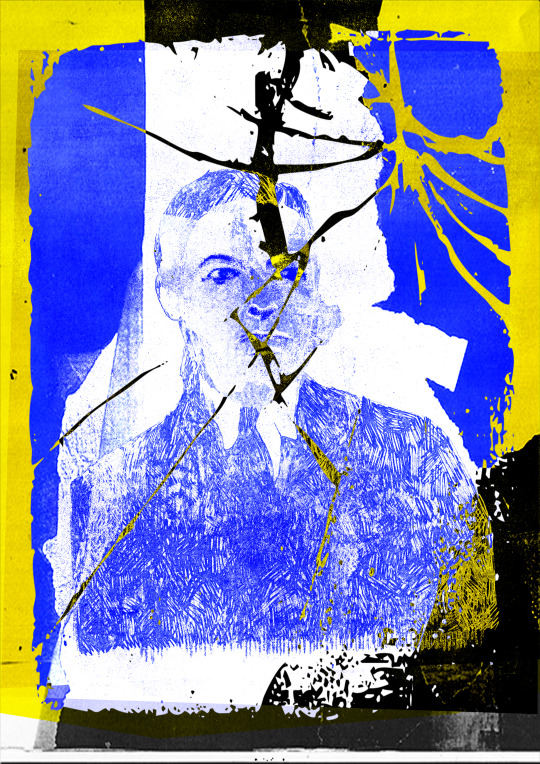
I made some minor changes to make them all somewhat match each other, which left me with these three different variants of the pictures from above:



Below is a picture of them hanging on the wall outside the studio in the same order:

02: Create an analytical page about your artist. Pick a piece of their work and a quote which you think connects with you and the way you work. Use notes and mapping to analyze the visual imagery.
0 notes
Text
𝕯𝖗𝖆𝖜𝖎𝖓𝖌 𝖆𝖓𝖉 𝖚𝖓𝖎𝖙 𝖊𝖎𝖌𝖍𝖙 | 04/03/20
Illustrations of peers based on the questions that we asked them. (James)
0 notes